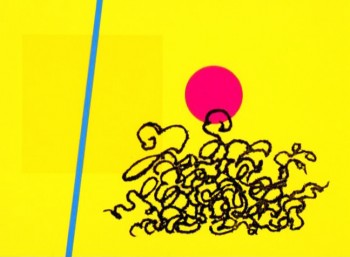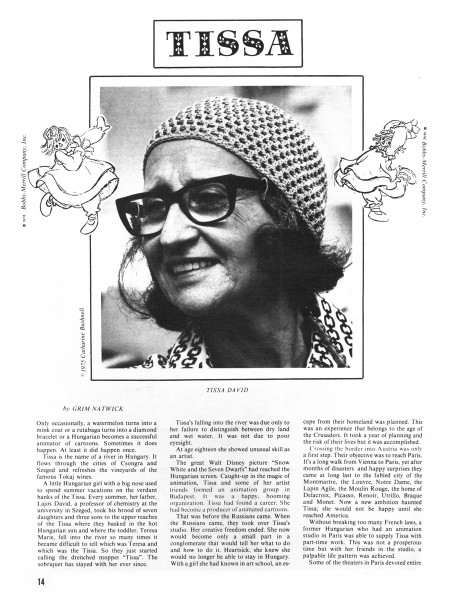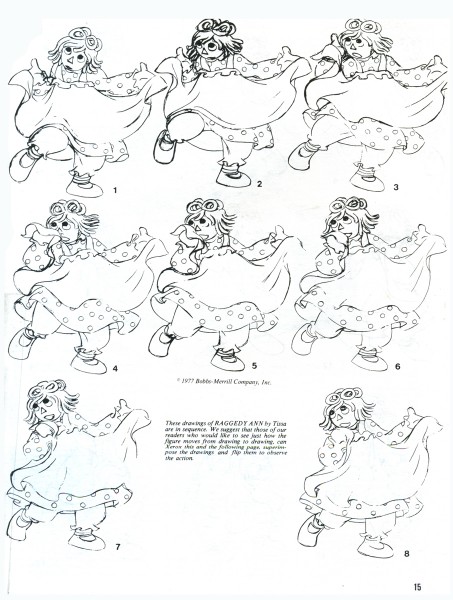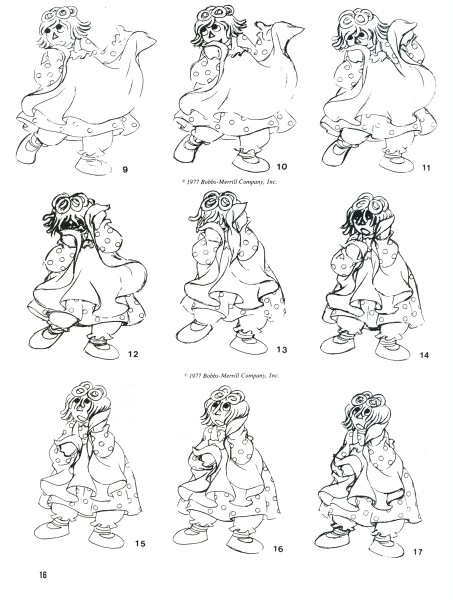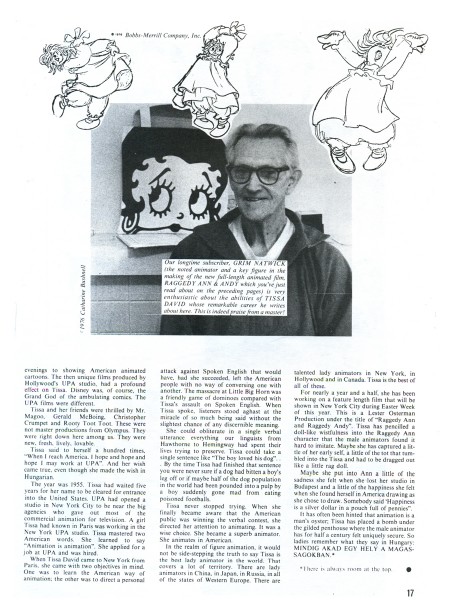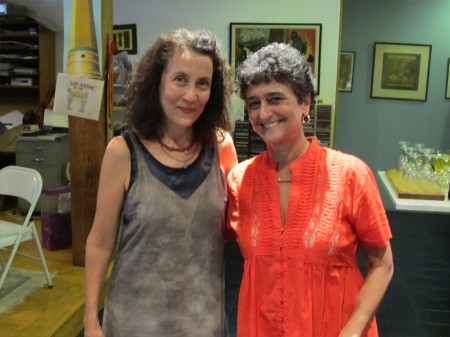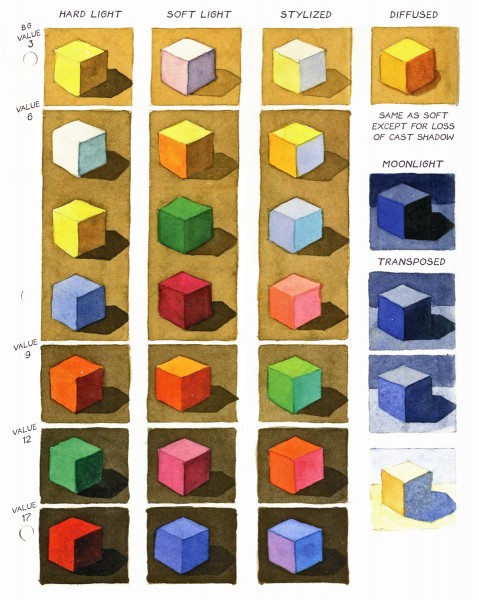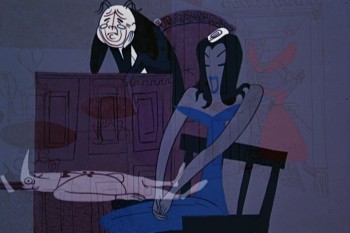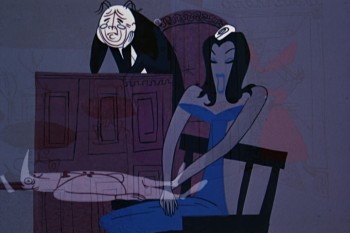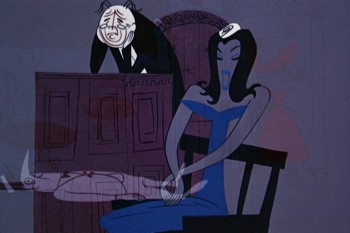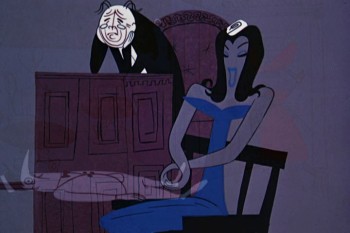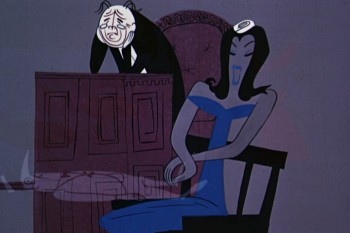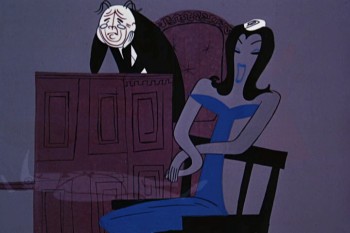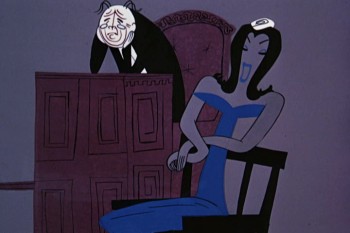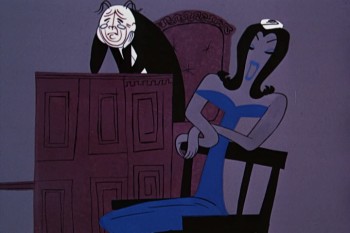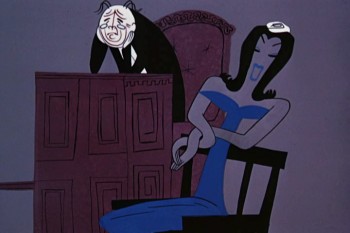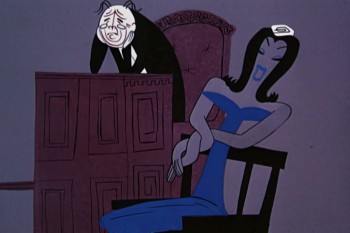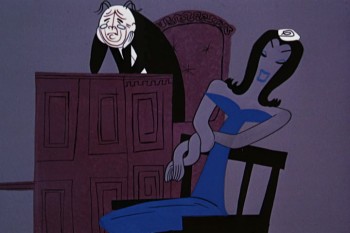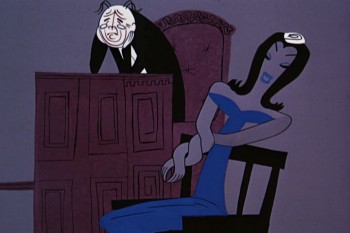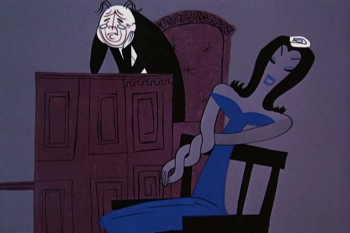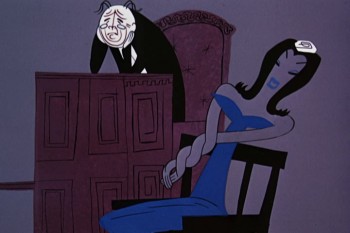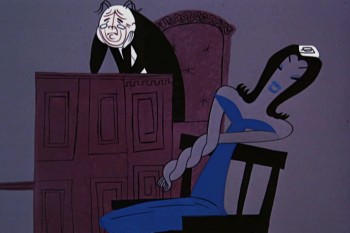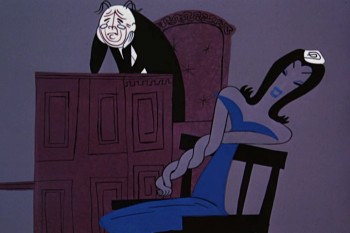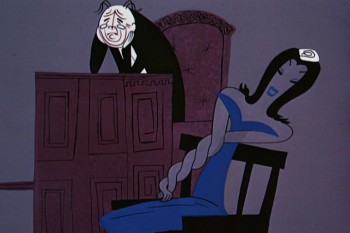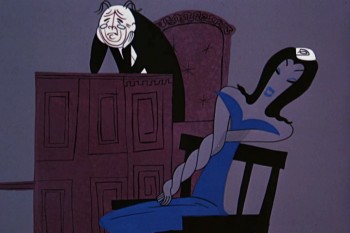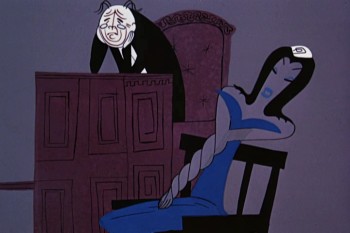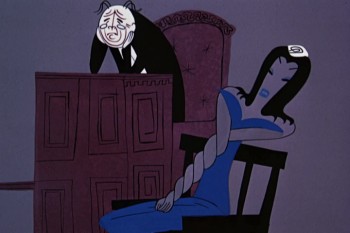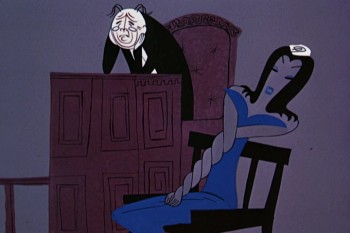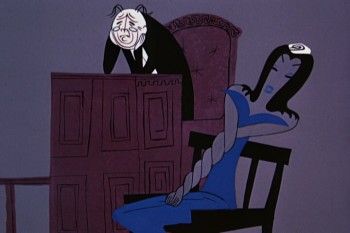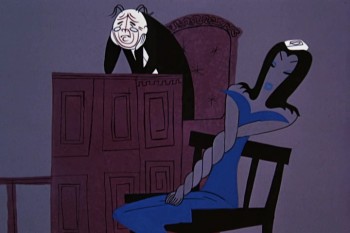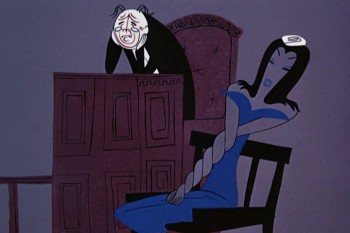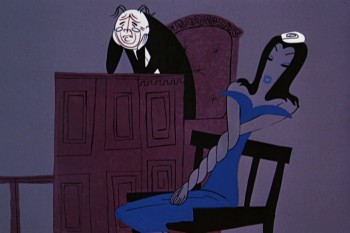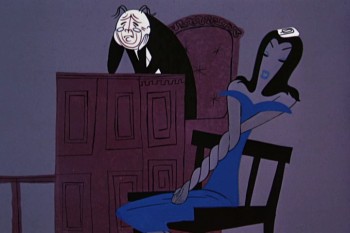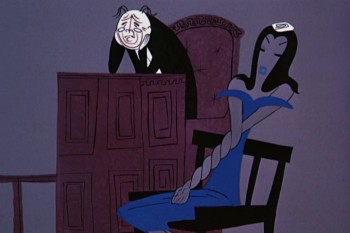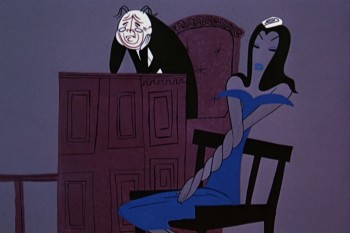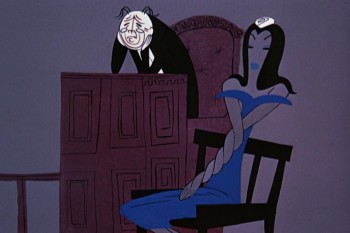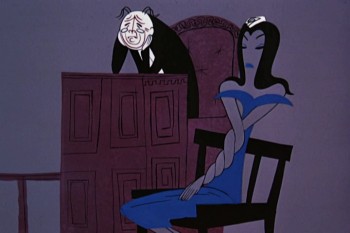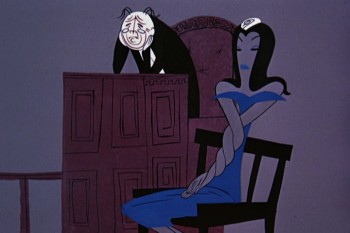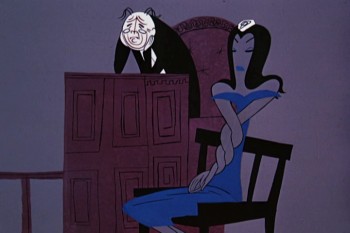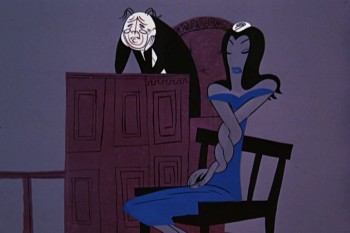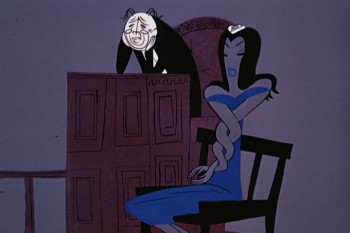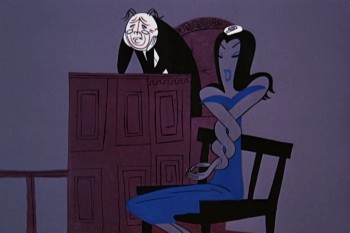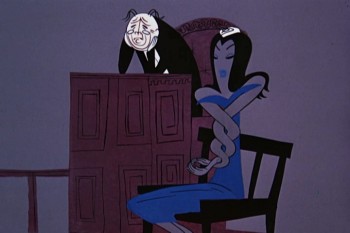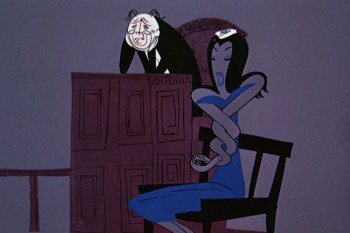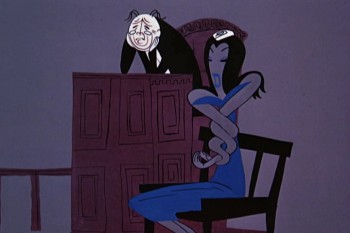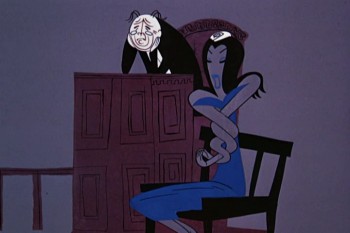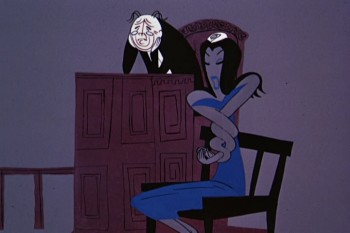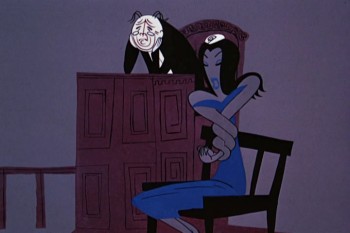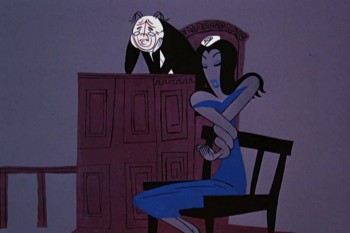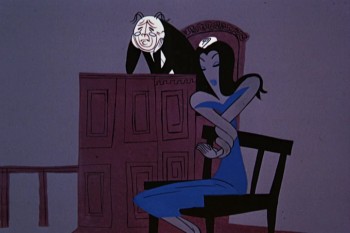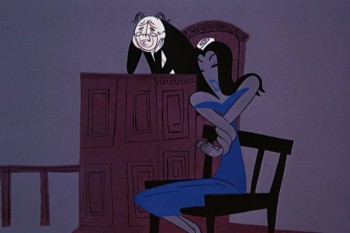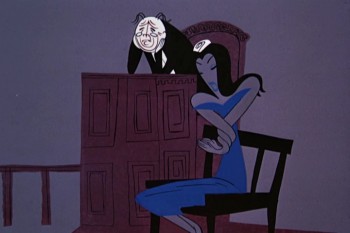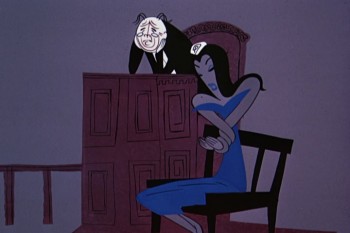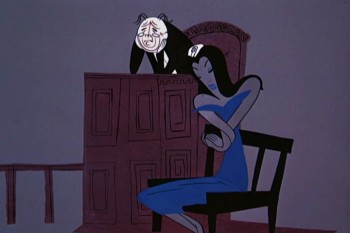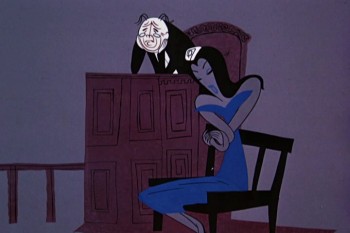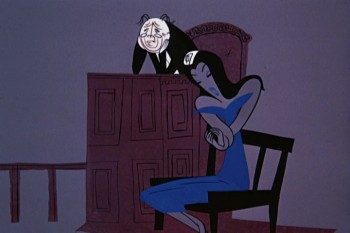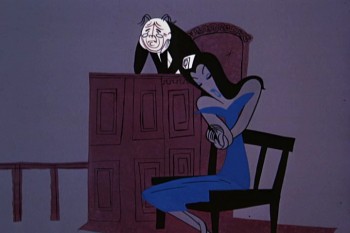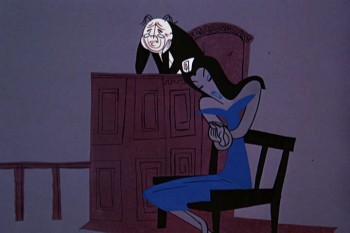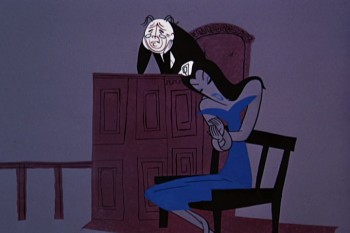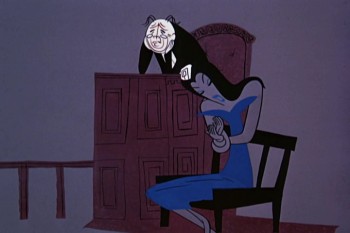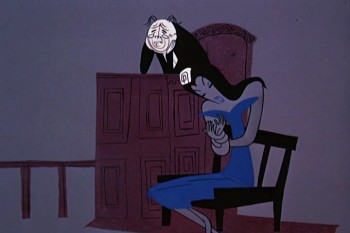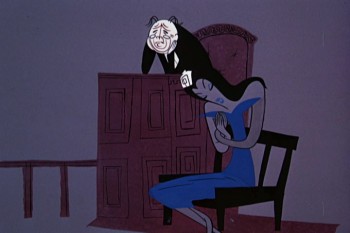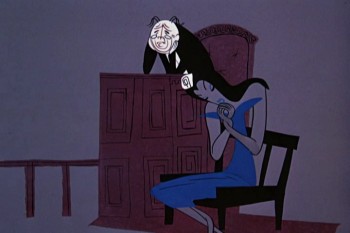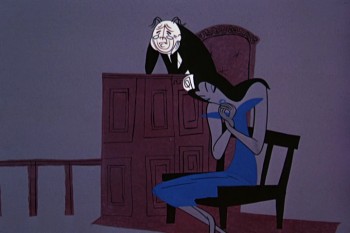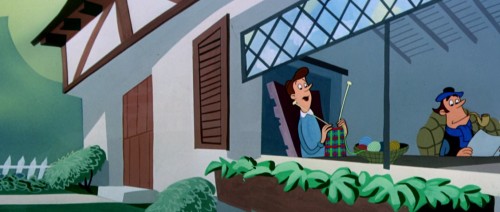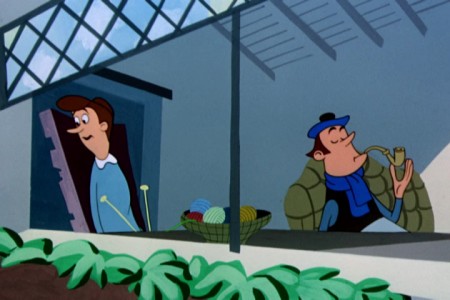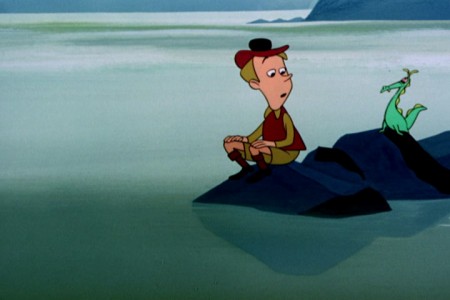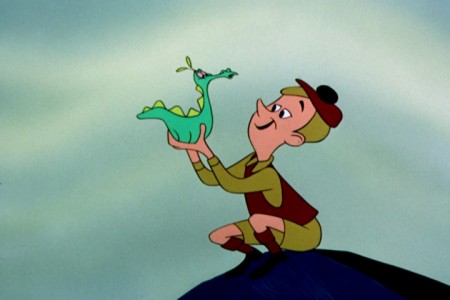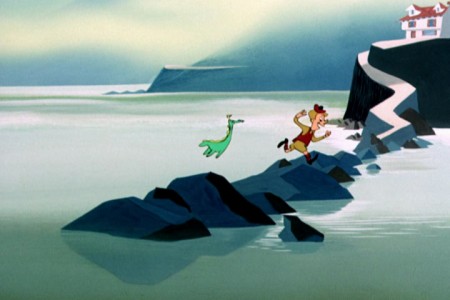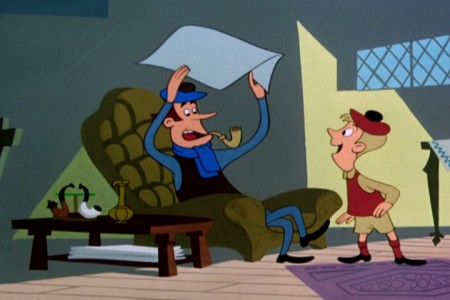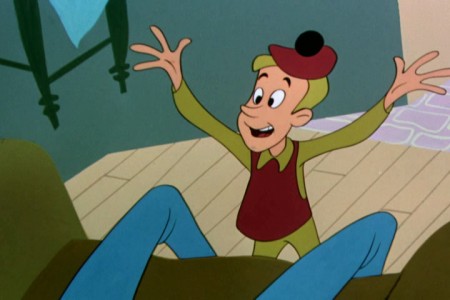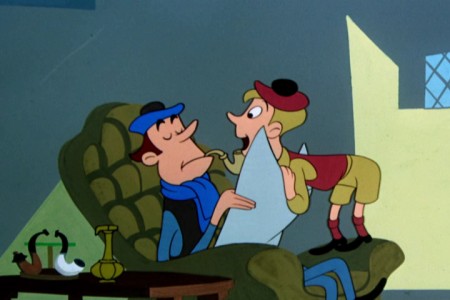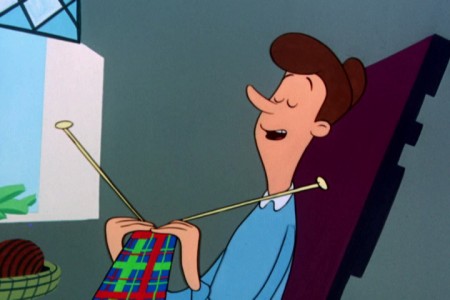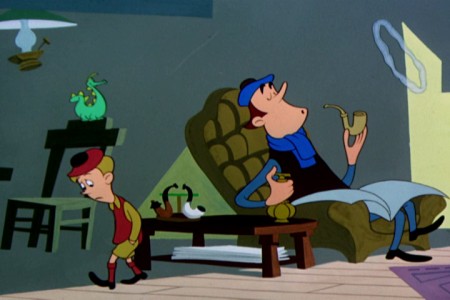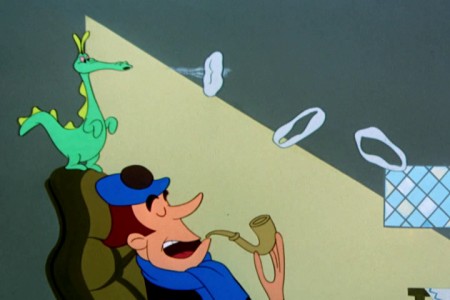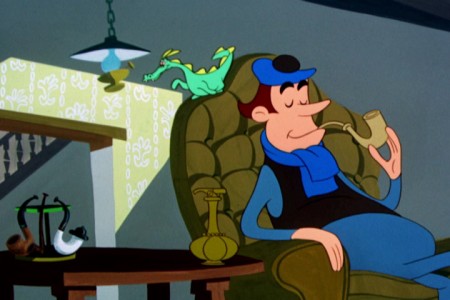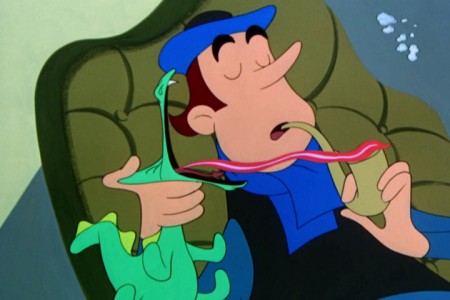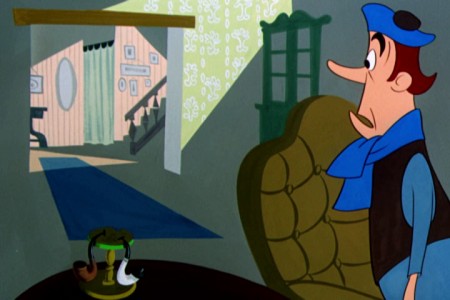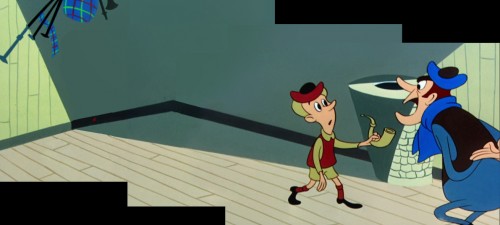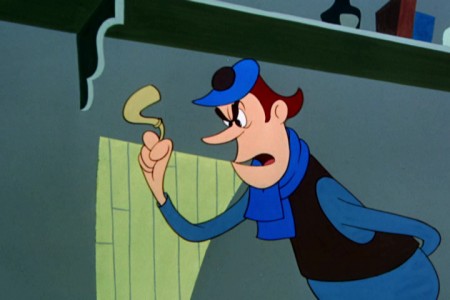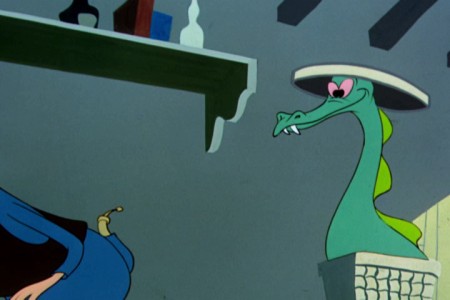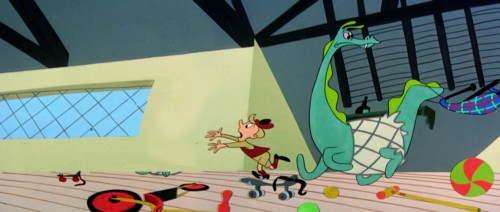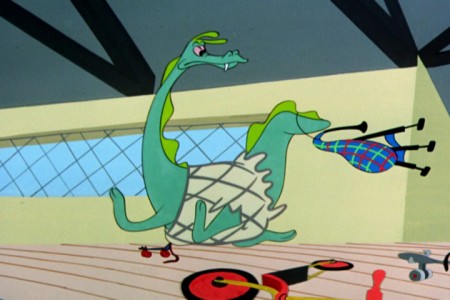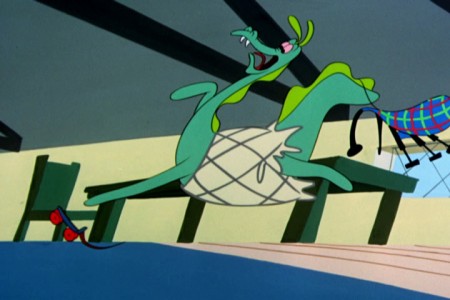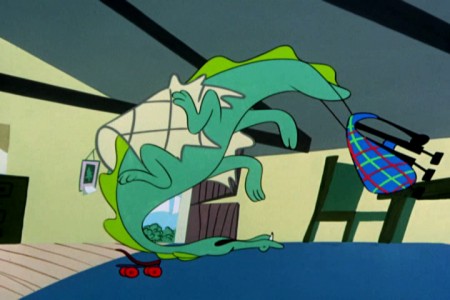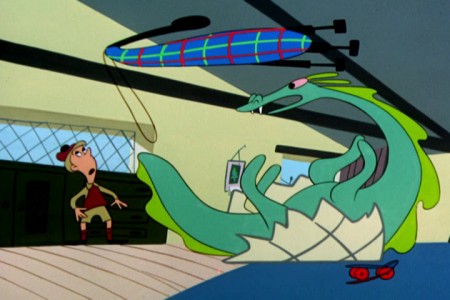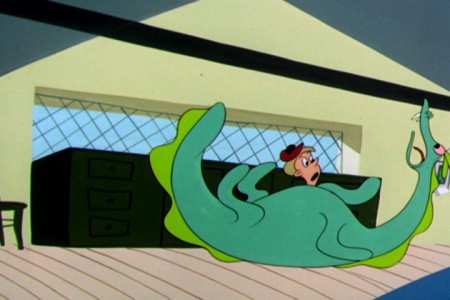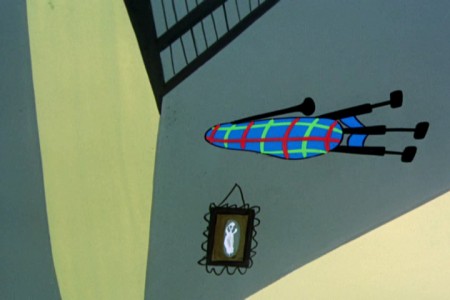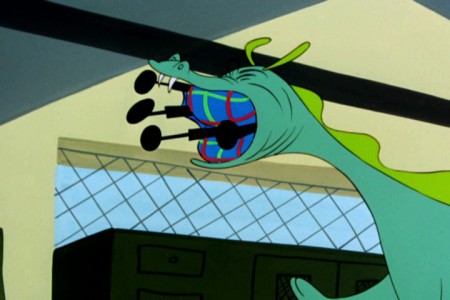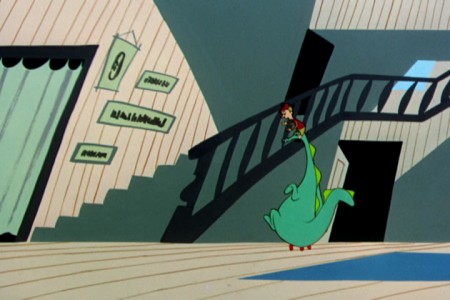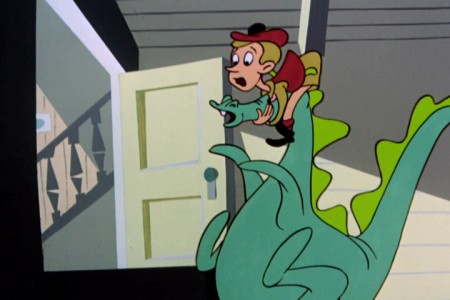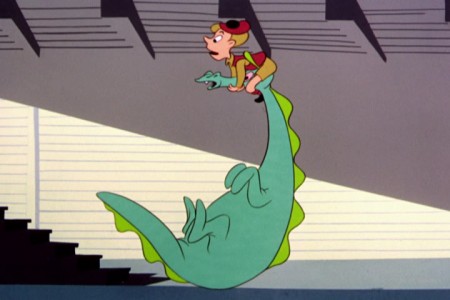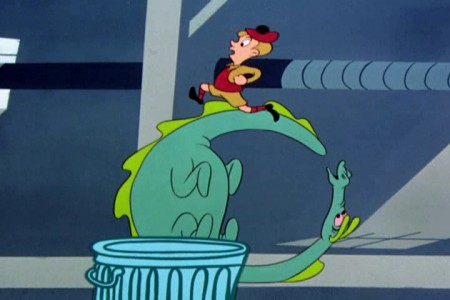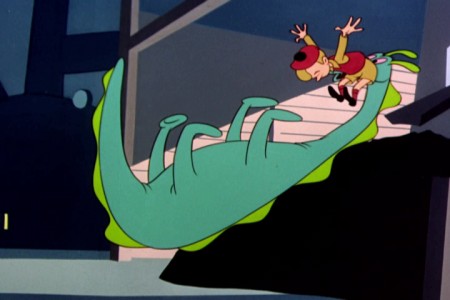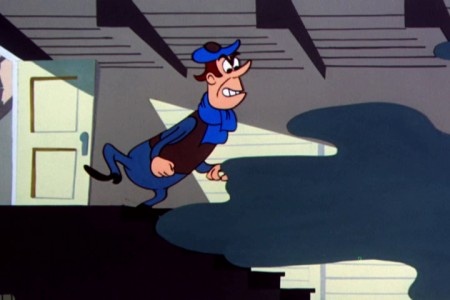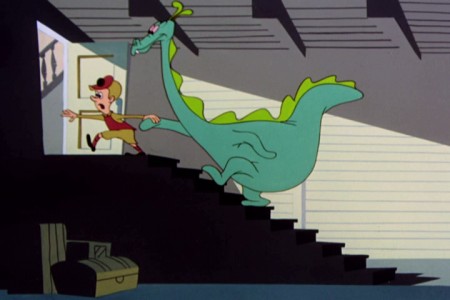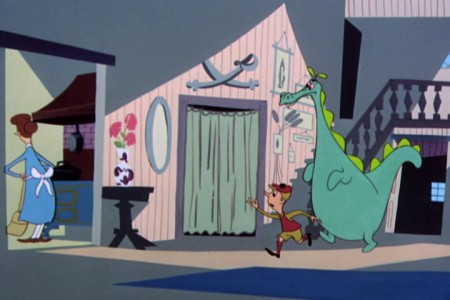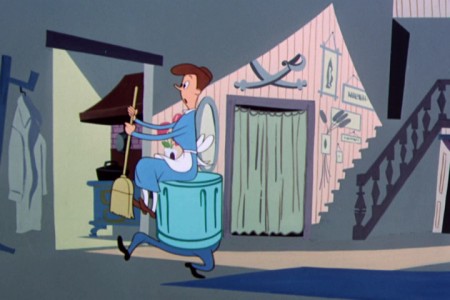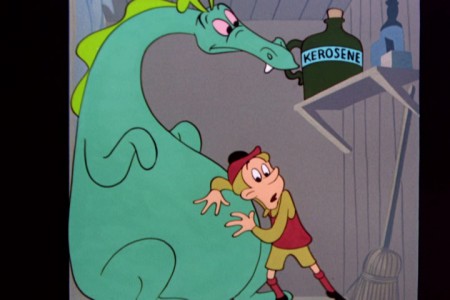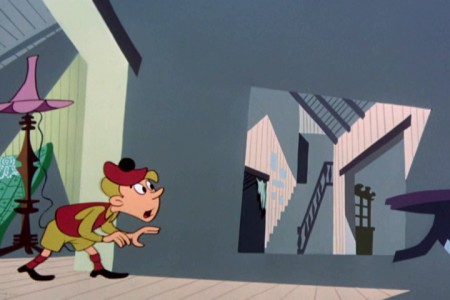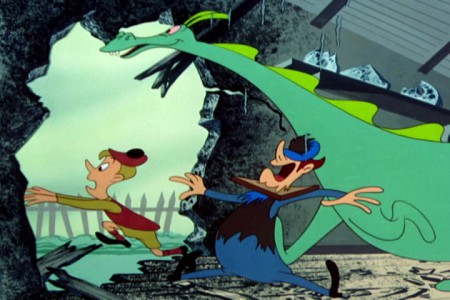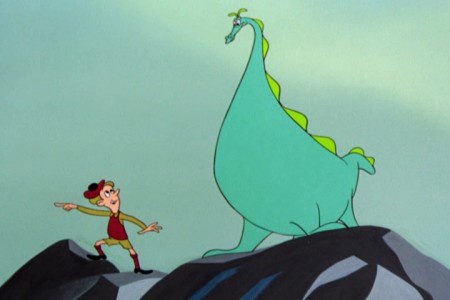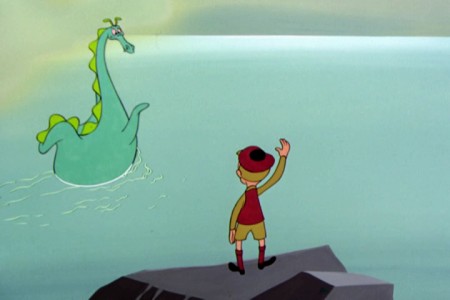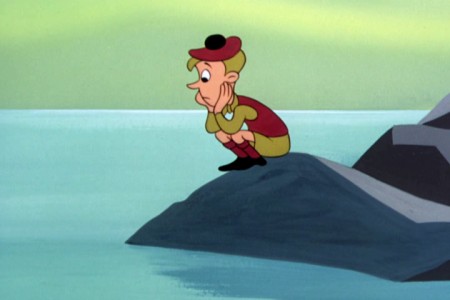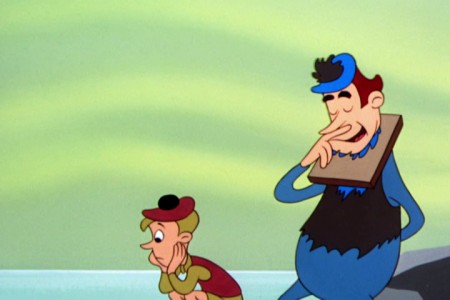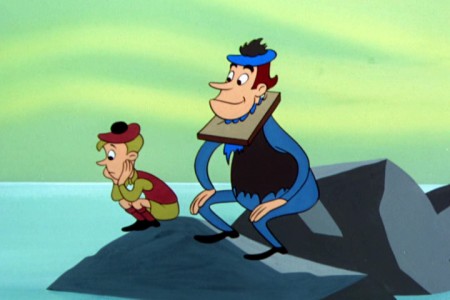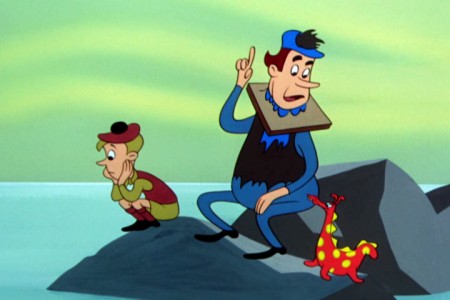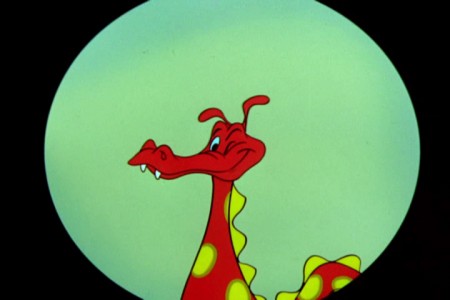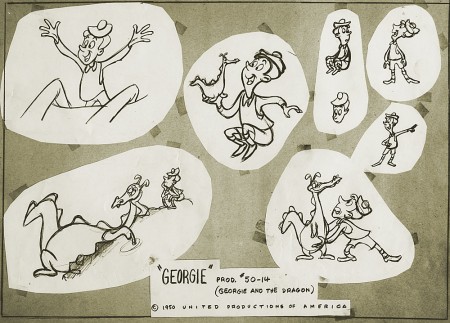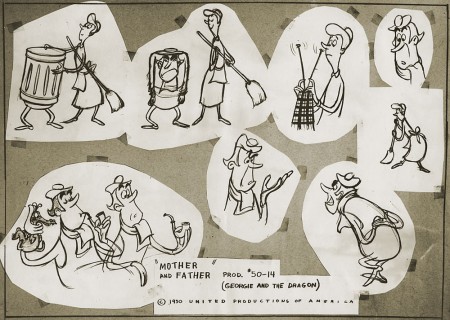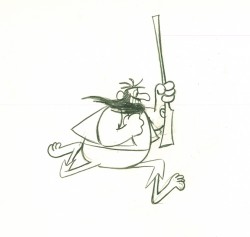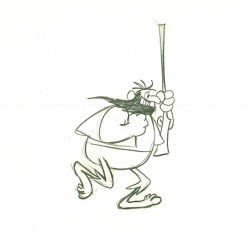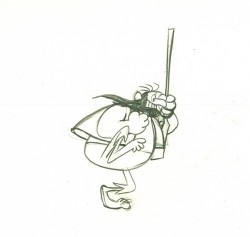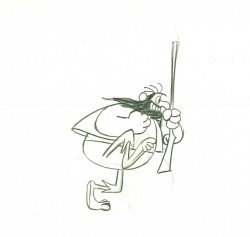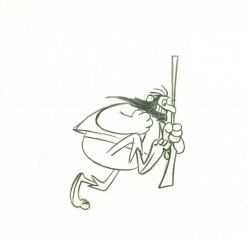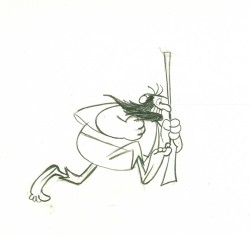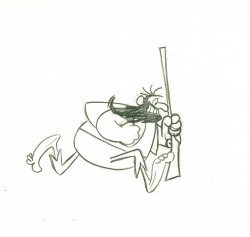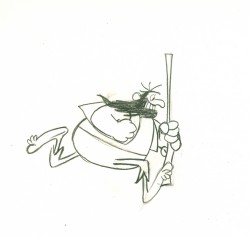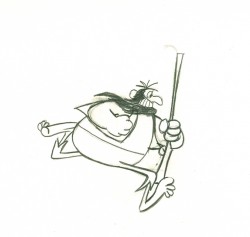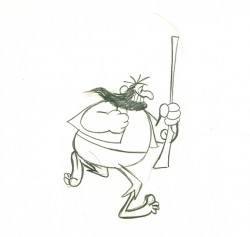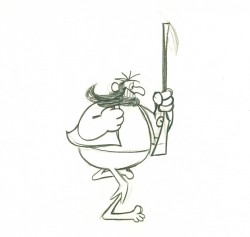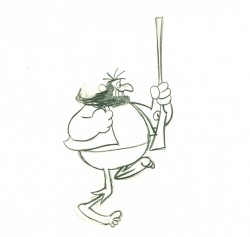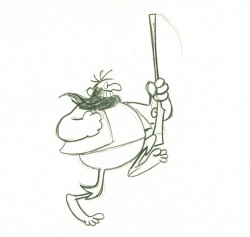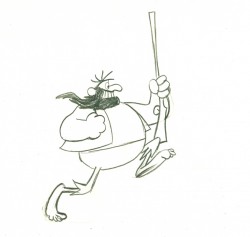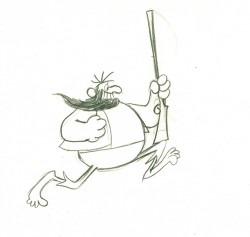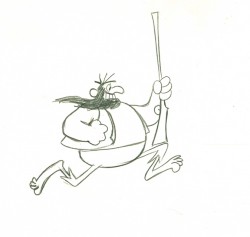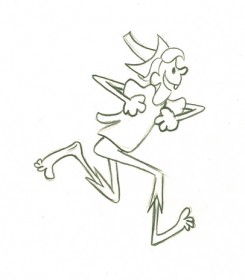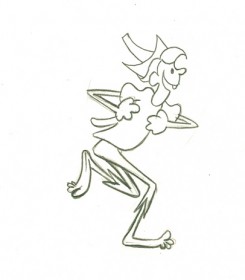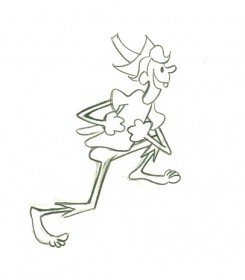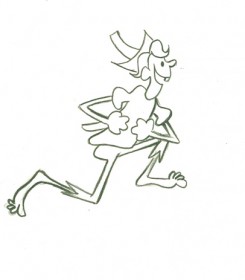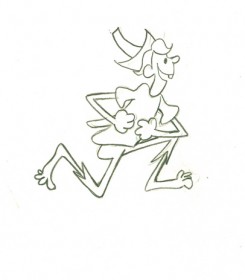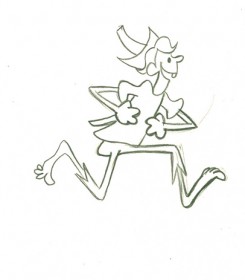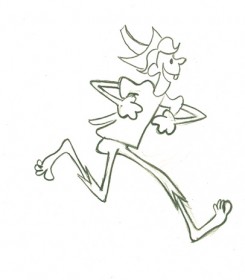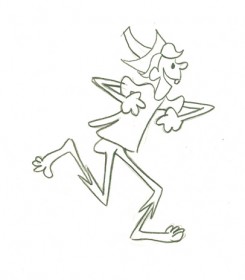Search ResultsFor "Grim Natwick"
Articles on Animation &Richard Williams &Tissa David 02 Sep 2012 04:21 am
Labor Day

Steve Fisher returns from his Summer with the perfect picture for Labor Day 2012.
Tomorrow is Labor Day. The photo shows a flag which at its base is in focus and grows more and more wildly out of focus as it moves from that base. That’s the American political system at this point in 2012. In the most important speech of his life to-date, Paul Ryan, Vice Presidential candidate, lied openly. When confronted by the obvious lies on CNN, he admitted it, rode right over the lies, defending what he’d said even though there’s no truth there and no reality to it. The man rides on the border of the insane, convinced that he’s right, and having no proof of it, makes it up. Somehow this makes sense to him but not to those of us who prefer honesty. The old media (not the “liberal media”) report their findings to him and he merely mocks them. Their basinc discoveries are irrelevant to him. He wants only to dupe his base and capture other simpe minded folk ot there. We, the bigger audience, can only take it in and vote when it gets to be our turn.
Just the same . . . _______ . . . Happy Labor Day
By the way, Labor Day exists as a celebration of the Labor movement, meaning the U-nions. They are the enemy of the political right, and those on the right should stand by their principles and go to work. Or, at least, shut up while they take the day off from work with salary. There’ll be plenty of time tomorrow for more lies.
Jones Doc to Air
- Tomorrow morning, at 10:15 am, Turner Classic Movies will air the Chuck Jones documentary, Chuck Jones: Memories of a Childhood. Undoubtedly, this is in conjunction with the Jones Centennial Celebration currently in progress. This film was directed by Peggy Stern, the producer who worked with John Canemaker on his Oscar winning film, The Moon and the Sun. Canemaker is a producer on this film.
It’s a 30 min film which will be followed by the Jones short, The Dot and the Line.
Grim Writes About Tissa
Here’s an interview Tissa David did with her mentor, Grim Natwick, for Cartoonist Profiles magazine.
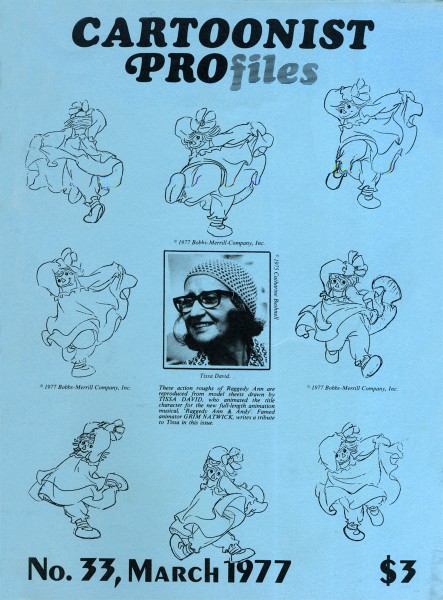
Magazine Cover
Commentary &Photos &Tissa David 27 Aug 2012 05:11 am
a Small, Friendly Memorial for Tissa
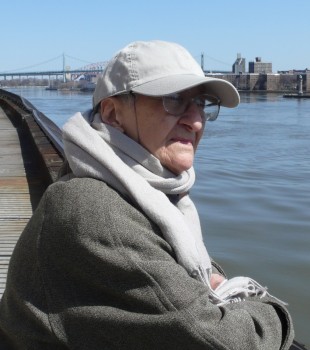 - I’d asked Tissa’s niece, Arlene Nelson, that she include me in any service they’d be having after Tissa died. She called to say that Tissa preferred only family at the religious services they’d be having. (Tissa was a devout Catholic, going to Mass daily – at least since I first met her back in 1972.) Arlene suggested a small memorial gathering at a restaurant, one that Tissa had liked. She recommended this Indian restaurant on the upper East Side. I immediately talked her out of that to find a more intimate approach. The difficulty of gathering a couple of tables for 20 people was troublesome, and we’d probably disturb the clientele on a weekend evening.
- I’d asked Tissa’s niece, Arlene Nelson, that she include me in any service they’d be having after Tissa died. She called to say that Tissa preferred only family at the religious services they’d be having. (Tissa was a devout Catholic, going to Mass daily – at least since I first met her back in 1972.) Arlene suggested a small memorial gathering at a restaurant, one that Tissa had liked. She recommended this Indian restaurant on the upper East Side. I immediately talked her out of that to find a more intimate approach. The difficulty of gathering a couple of tables for 20 people was troublesome, and we’d probably disturb the clientele on a weekend evening.
I called Candy Kugel to see what ideas she had. She suggested we have it at Buzzco, her studio. She had a couple of long tables which she’d place together, and we could sit, eat snacks (cheese, fruit, veggies) and have a glass of wine while chatting over memories of Tissa.
All very impromptu with less than 24 hours to organize.
There were about 8 family and friends that would come, and I said I’d match that number with animation people that had known Tissa for years. John Canemaker and Joe were going to be out of town; Emily Hubley would also be out of town.
However, John and I briefly discussed an official memorial we’d like to organize for the animation community. John and I will arrange this memorial within the next 4 to 6 weeks. We’ve already started to search for a place where we can screen films and talk on mike.
In the end, there were these people who came to the gathering:
Bob Blechman, Richard O’Connor, Candy Kugel, Dick Rauh, Howard Beckerman, Tony Eastman, Jimmy Picker, John Dilworth and Lisa Crafts. Of course, Heidi and I were also there.
It was to start at 3pm; I bought four bottles of wine, Candy made Lemonade – which was, really, the drink of choice. John Dil brought a bottle of Hungarian wine in honor of Tissa. I bought five different types of cheese and four different kinds of crackers. Everybody had arrived by a few minutes after three. Punctual.
Let’s look at some pictures:
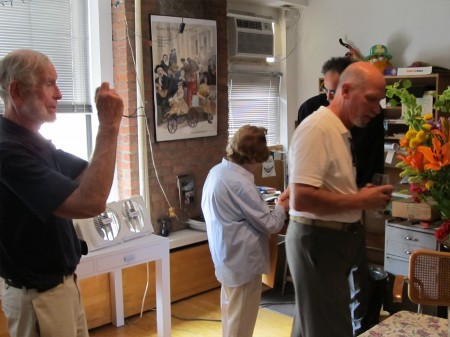 1
1(LtoR) Howard Beckerman, Ruth Mane,
John Dilworth behind Ray (Tissa’s cousin)
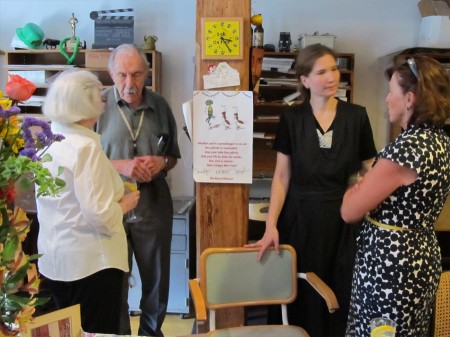 2
2
Susan Davis, with Dick Rauh
Arlene, Tissa’s niece from Virginia,
talking with Marilyn, Tissa’s cousin from Mass.
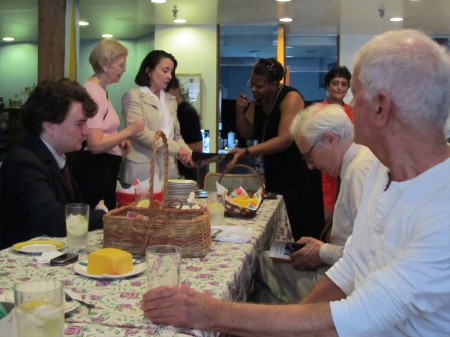 3
3
(LtoR) Richard O’Connor, Beth (an ex-nun who gave Tissa
religious services daily throughout this entire period), Heidi,
Sheryl (Tissa’s nurse), Bob Blechman (seated) Candy (in the rear),
Tony Eastman (far right front).
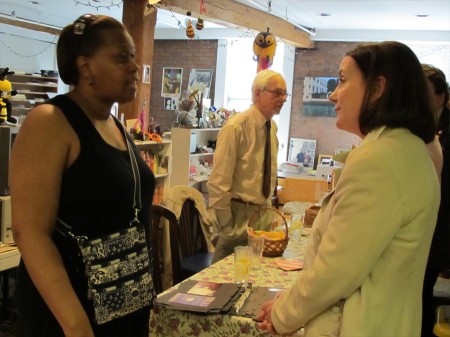 5
5
Sheryl talking with Heidi in the foreground,
Bob Blechman between them in the rear.
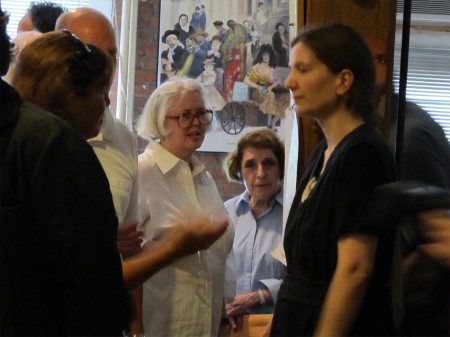 6
6
Marilyn and Ray David (left foeground),
Susan Davis (in white) talking with Arlene.
Ruth Mane is in the middle, between them.
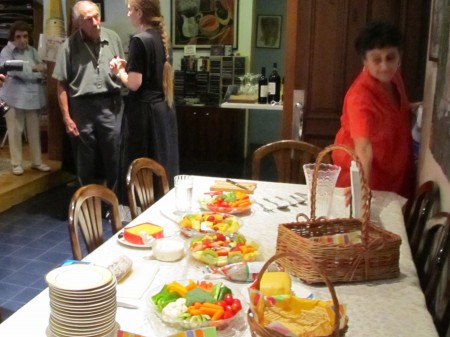 7
7
Candy is setting food & snacks on the table.
(LtoR in rear) Ruth Mane, Dick Rauh, Arlene
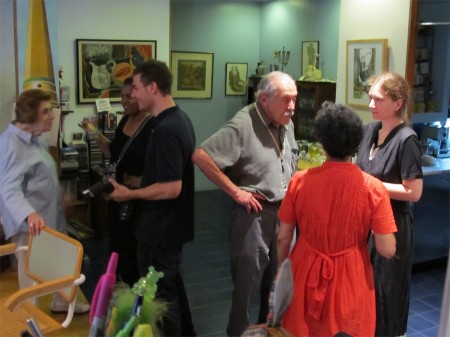 9
9
(LtoR) Ruth Mane, Sheryl, and Andras talk.
Dick Rauh, Candy Kugel and Arlene.
At this point, I decided it was time to get the show on the road. I suggested that
we all sit down and take turns talking about Tissa, telling stories we remembered.
Telling Stories
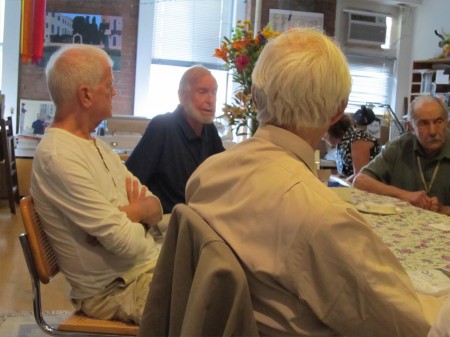 11
11
(LtoR)Tony Eastman, Howard Beckerman, Bob Blechman
Howard Beckerman started things off saying that he was at the very place
where Tissa got her NY start – UPA. The department manager asked
Grim Natwick to interview Tissa, who could barely speak English.
Grim brought her into the large vestibule and asked Tissa what she
thought animation was. Tissa responded, “Animation is . . . animation.”
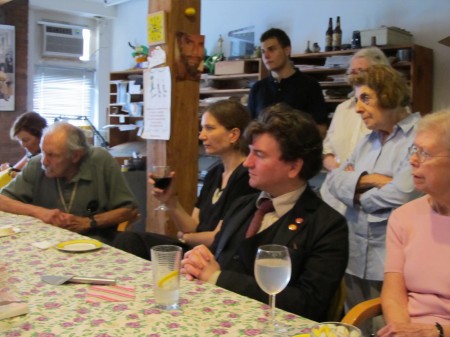 12
12
(LtoR) Marilyn David, Dick Rauh, Arlene Nelson, Andras (in rear)
Richard O’Connor, Susan David (in rear), Ruth Mane, Beth.
Howard’s story is oft told, though he had more details than usual.
Tissa gave me her side of the story. She didn’t really understand
what Grim was asking her, and this was her way of trying to clarify.
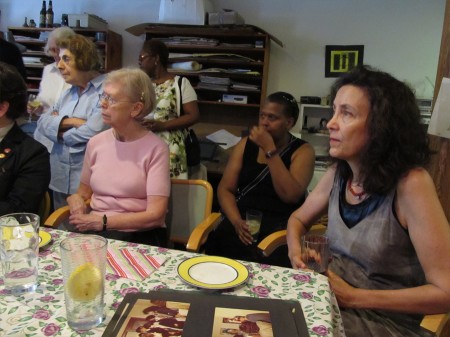 13
13
(LtoR) Susan Davis (in rear), Ruth Mane, Beth, Sheryl, Lisa Crafts.
Grim hired her because of that answer, and
the two became close for the rest of their lives.
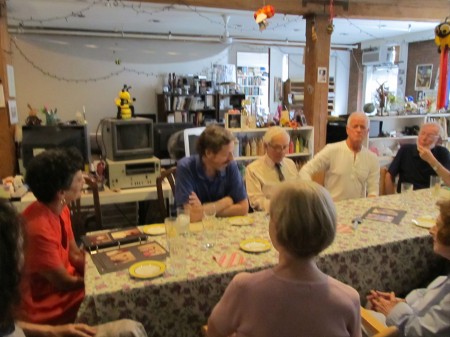 14
14
(LtoR rear of table) Candy Kugel, Heidi Stallings (hidden) me, Bob Blechman,
Tony Eastman, Howard Beckerman. (Front of table) Beth, Ruth Mane
Bob Blechman picked up the story telling. He talked about some credit that
was being drawn for one of his projects. (I think it was Simple Gifts.)
The designers were credited as “Artists” and Tissa wanted to know why she wasn’t
credited as an “Artist” as well. (Only the “Artists” received credit in the publication.)
Bob said he made sure that Tissa got the credit as “Animation Artist” because,
“she was a true “artist”.
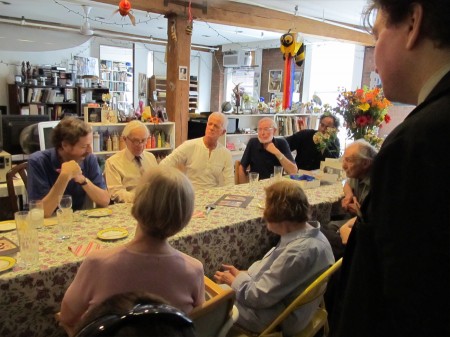 15
15
(LtoR – rear of table) me, Bob Blechman, Tony Eastman,
Howard Beckerman, John Dilworth
(Front of table) Beth, Ruth Mane, Dck Rauh, Richard O’Connor up close on RIght
I then told the story of my first meeting Tissa at the Hubley studio.
In the I&Pt room, there were only two people working on a commercial,
Helen Komar (an Asst. Animator working, then, as a prod. coordinator) and me.
While working furiously on my artwork, I heard a Hungarian voice in the room:
“Who has done these HORRIBLE inbetweens?”
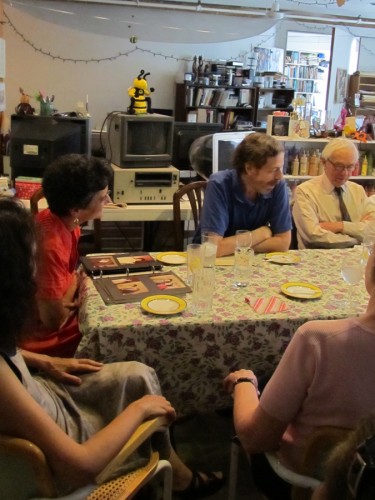 16
16
(LtoR – rear of table) Candy Kugel, me, Bob Blechman
(Front of table) Lisa Crafts, Beth
I was the obvious culprit and nervously raised my hand. They had their
smile and then Tissa took me under her wing to teach me about animation.
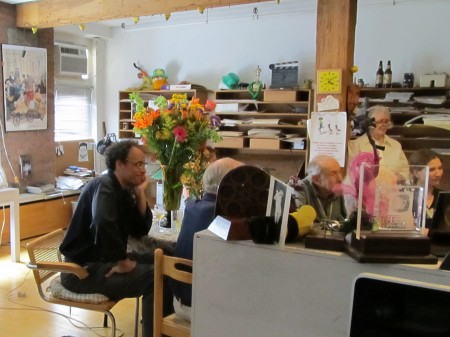 17
17
(LtoR) John Dilworth, Howard Beckerman (partial view of back),
Dick Rauh, Susan Davis, Arlene Nelson
I’d go to Tissa’s apartment about once or twice a week and she’d
give me Grim Natwick drawings to either clean up or inbetween.
Then she’d tear me apart for the work I’d done.
Eventually, I learned a thing or two about animation.
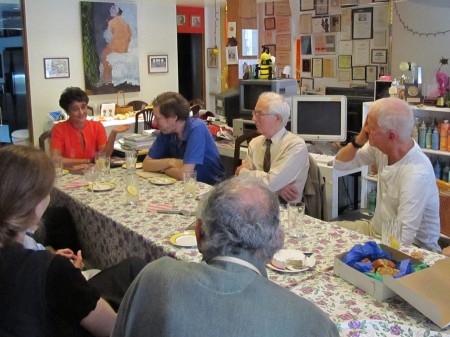 18
18
Candy told of meeting Tissa and, having talked with her over the phone,
thought Tissa was much younger. Candy was ultimately surprised to find
someone as old as her mother. She took similar lessons from Tissa, but
Candy felt that her skin wasn’t quite as thick as mine. Taking the hard
words from Tissa wasn’t always easy.
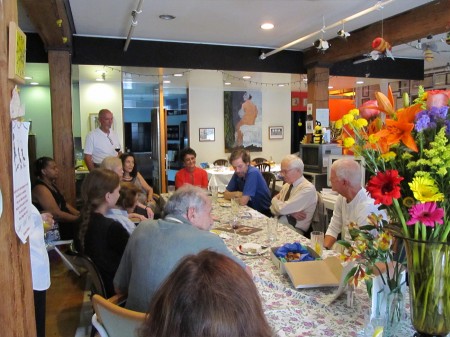 19
19
Candy also talked about a memorable dinner; Tissa cooked a Hungarian
dinner for John Canemaker, Candy Kugel, me and some of our companions.
Candy, at the time, was a vegetarian. Tissa didn’t know. Candy felt she
could eat around the meat. Unfortunately, the meal was goulash, and
Candy had more than a little difficulty eating it.
Candy eventually became a carnivore, and Tissa became a vegetarian.
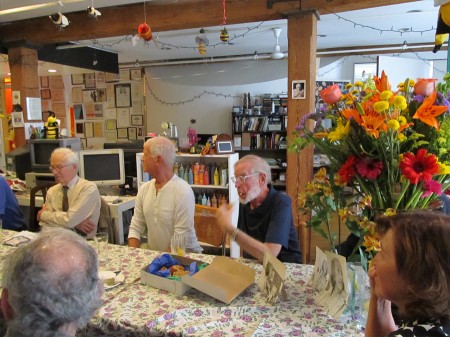 20
20
From here the story-telling became more of a conversation with a lot of
back and forth about ASIFA and animation and Tissa’s work. It was
mostly light and funny and fun.
The gathering eventually had to break up since some of us had trains to catch or places to get to. However, it was an enjoyable couple of hours remembering someone who was so dear to all of us present. We’d have to look forward to the official memorial we’ll set up in the next month or so.
Here’s some background on those people in the snaps:
- Bob Blechman, the producer director of films especially featuring his own squiggly lined character. A famous designer and cartoonist who hired Tissa for years out of his studio, The Ink Tank.
- Richard O’Connor, a producer director out of his own studio, Ace and Son. He first met Tissa when he worked at Blechman’s studio. Eventually, he worked with her on many a spot from his own studio.
- Dick Rauh, the first President of ASIFA-EAST with Tissa as his Treasurer. They ran the chapter for many ears. He also was the head of the Optical House, a prestigious producer of film opticals. He retired to draw stunning botanical illustrations.
-Howard Beckerman, was a mainstay in animation. He worked at UPA when Tissa was first hired there. He was a designer/animator/director at Paramount. Eventually, he had his own studio for many years in NY. He was one of the leading instructors at the School of Visual Arts. In fact, he still teaches there. Oh yes, he’s also written several books.
- Candy Kugel has been in animation since the early 70s, first at Perpetual Motion Studios, then Buzzco Productions, which ultimately left the hands of Buzz Potamkin and became a joint venture between she, Marilyn Kraemer and Vince Cafarelli, as partners, Buzzco Associates. She’s responsible for MTV’s first ID, the spaceman with the flag.
- Tony Eastman, an animator and designer. The son of UPA writer and author, P.D.Eastman. Tony now continues the book series his father started. He worked for years at the Ink Tank before going into business for himself.
- John Dilworth, director and animator and proprietor of the studio, Stretch Films, from which he produced “Courage, the Cowardly Dog”. His character and the show’s pilot, was nominated for an Oscar.
- Jimmy Picker, the Oscar winning clay animator who has been something of a quiet center for a lot of animation in this City.
- Lisa Crafts, a brilliant Independent animator. She has been making her own films for decades now and has worked at numerous studios about town, including my own.
Tissa’s friends and family:
- Arlene Nelson, Tissa’s niece, the daughter of Tissa’s sister. She came up from Virginia to settle and arrange all the affairs.
- Susan Davis, the friend of Tissa who diligently helped her every day dring this long and tiring period. Susan also notified a large number of people to keep them abreast of any changes in Tissa’s condition. We spoke often, about once or twice a week.
- Sheryl, the nurse who moved in with Tissa after the most recent hospital stay. At first, Tissa objected to having a nursing aide. Within a few days she told me privately that she enjoyed Sheryl’s companionship (not to mention her assistance). They watched the Olympics together.
- Ruth Mane, a dear friend of Tissa’s for many years. Ruth was a remarkable inker and checker during the years of the big studios. She was well known for her brilliant, meticulous lettering.
- Andras, Tissa’s great, grand nephew. He came from Hungary to visit his aunt, arriving on Tuesday, the day Tissa died. He took many photos of the event.
- Beth, an ex-nun who came to Tissa daily over the past four years to help her perform her daily religious service. She administered the Eucharist on more than one occasion while I was present.
- Ray and Marilyn David, Tissa’s cousins from Massachusetts.
.
Photo of Tissa, above, by Mate Hidvegi taken this past March.
The Los Angeles TImes printed an Obituary for Tissa David, which you might appreciate seeing. (The Chicago Tribune printed this same obituary from the LA Times.)
Commentary 22 Aug 2012 08:03 am
Tissa David 1921-2012
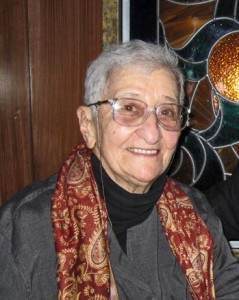
Tissa David was 91 last January.
Tissa David died last night.
In the past month, it was discovered that Tissa had a tumor which formed on her brain and was growing rapidly. She went home from the hospital, rather than experience a difficult operation, which she, at the age of 91, wouldn’t survive. It would be better to go out gracefully.
I visited her several times a week, if I could. Our conversations amounted to my being as cheerful as possible remembering as much as I could and discussing old friends and good times. I tried to sound as gossipy as I could, and Tissa enjoyed that. We also talked about animation: the mechanics of animation and different styles of animation. Her memory was clear as long as I was talking. When she tried to answer a question, the memory didn’t work, and Tissa would just say, “I don’t know. I don’t know.”
Last night, while I was out, her good friend and caretaker, Susan Davis, called leaving a message for me to return her call to Tissa’s apartment. I had intended to visit Tissa again today, Wednesday.
Tissa died yesterday evening, August 21st, in her Manhattan apartment at 7:35 PM.
To give some background information about Tissa David, I’m reposting this Millimeter article that John Canemaker wrote in 1975. I’ve added some to it.
- The 1975 issue of Millimeter Magazine is an animation issue. There are a number of enormously informative articles. I was rereading a copy of the magazine, this past weekend, when I came across the Close Up section, wherein a couple of bios appear.
I’d like to show one for Tissa David that was included. I assumed John Canemaker authored the piece; there is no byline. When I asked him, he responded thus: “I wrote the article on Tissa. The quotes are from my first formal interview with her. It was for Millimeter when I was the animation editor and put together special animation issues.”
Tissa looks so young in that photo.
-
“I am a frustrated comedienne, for sure,” Tissa David will tell you, only if you ask. “I am a clown. If I weren’t shy, I’d probably be on the stage.” Instead she is an animator, one of the world’s best and busiest, and one of the few women to have reached the top in the traditionally male-dominated animated cartoon field.
She joyfully toils in her East-Side New York apartment, a warm, plant-filled place that often smells of baked apples. Classical music swirls quietly from a radio and the glow cast from the light under her animation board gives her the look of a sorceress.
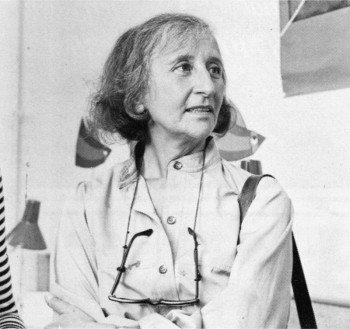 The lady has class—a fact one gathers upon first meeting, but a fact that is reaffirmed by catching a look at the creatures she is conjuring to life on her drawing board. The graphic line is strong and free, yet elegant (as is the artist); and when the drawings are flipped, the creatures move through their paces with a deliciously droll humor, a wit that is uniquely Tissa David’s.
The lady has class—a fact one gathers upon first meeting, but a fact that is reaffirmed by catching a look at the creatures she is conjuring to life on her drawing board. The graphic line is strong and free, yet elegant (as is the artist); and when the drawings are flipped, the creatures move through their paces with a deliciously droll humor, a wit that is uniquely Tissa David’s.
As a child in her native Hungary, Tissa saw Disney’s SNOW WHITE and thought (as so many others have thought after experiencing that film masterpiece), “Now this is something I want to do.” After graduating from art school, she became an assistant animator at Magyar Film Iroda in Budapest; a little more than a year later, in 1945, she was a co-owner of the Studio Mackassy and Trsi supervising all phases of production including story and camera and was sole animator of the puppet and cartoon films.
She left Hungary in 1950 during the height of the Stalin regime, and finally landed in Paris.
Jean Image Productions hired her in September 1951 and for two years she read sound tracks, planned layouts, animated, and did the entire editing of the feature-length, BONJOUR PARIS (1953). That studio closed and Tissa animated at La Comete next, a studio that had been Paul Grimault’s.
“I had absolutely no relatives outside of Hungary except in the United States. So I asked for a visa in 1950. It took at that time five years to get a visa, that was still the quota system. So I came to New York…I loved the U.P.A. cartoons. I decided I wanted to work in that studio.” In 1956, the United Productions of America’s New York Studio was the last tenant in a brownstone on Fifth Avenue and 53rd Street slated to be torn down for the construction of the 666 Tishman Building. There was a French girl in the UPA studio and so she introduced me,” Tissa recalls. “I had no sample reel. I went in once to make a sort of tryout. I was scared; I didn’t speak English, so I was just waiting, waiting, and Grim came by…Grim Natwick is the history of animation and I can rave about him. He created Betty Boop and animated the character of Snow White all the way through. UPA had an awful lot of work and they needed an assistant to Grim.”
At that initial meeting, Natwick boomed, “Now, you know what animation is!” Tissa quietly answered, “Animation is—animation.” Natwick laughed, “You can’t argue with that!” and thus began a professional partnership that lasted twelve years. “Isn’t it strange,” says Tissa today, “that SNOW WHITE got me into animation and I really learned my animation from Grim. I know a great deal about animation, I know I know, because even today I don’t do one line without something in my brain Grim told me.”
After UPA closed in 1958, Tissa and Grim freelanced as a team on countless TV commercials, and since Grim’s retirement, Tissa has soloed successfully and most notably on several John Hubley projects, i.s.: Of Demons and Men (1970), Eggs (1970), Children’s Television Workshop segments Cool Pool Fool, True Blue Sue, Truth Ruth and others, and Cockaboody (1973). Her latest animations include three CTW Letterman episodes, a scene in Shamus Culhane’s Noah’s Ark production, and over 110 feet of Hubley’s Bicentennial film, People, People, People. She has just completed some experimental animation fora Dick Williams project and is now starting, also for Hubley, a TV special based on Erik Erikson’s writings.
A description of Tissa David’s style of animation is difficult; for while it is a distillation of the Disney influence in timing, the UPA sense of humor-through-graphic-design, and the strong, poetic John Hubley mode, it also contains a different character, unique to Tissa David, that she calls the “female difference…If the same scene is animated by a man and by me, there will be a great difference, not in quality but in interpretation. John Hubley told me I have a fine sense for detail, not in the drawing itself because I make very loose drawings, but in a scene, in expressing feelings. I am a very intuitive animator—I never know when I sit down to work what will happen.”
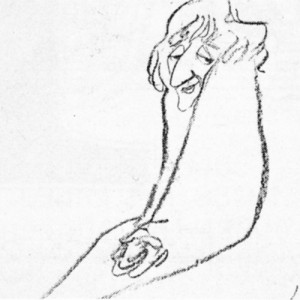 For all her gentleness, Tissa also contains an inner core of strength exhibited in her single-minded devotion to her art. Her opinions about that art, herself and other topics, is disarmingly to-the-point: “I believe very strongly that one must know how to draw,” she will offer on the subject of how-to-animate. “Even if you just animate objects, you must have a knowledge of drawing.” As for her struggles securing her place in animation, Tissa will admit, “…its very hard. Women can find work in animation if they have enough will to follow through and really do it. Even today, I’m always saying if I keep busy long enough, I will become a good animator.”
For all her gentleness, Tissa also contains an inner core of strength exhibited in her single-minded devotion to her art. Her opinions about that art, herself and other topics, is disarmingly to-the-point: “I believe very strongly that one must know how to draw,” she will offer on the subject of how-to-animate. “Even if you just animate objects, you must have a knowledge of drawing.” As for her struggles securing her place in animation, Tissa will admit, “…its very hard. Women can find work in animation if they have enough will to follow through and really do it. Even today, I’m always saying if I keep busy long enough, I will become a good animator.”
At the time this piece was written, Tissa was completing work on a pilot for Dick Williams’ film, Raggedy Ann & Andy; this one minute piece got Dick the film over Joe Oriolo and Shamus Culhane. She would thereafter work on John Hubley’s Doonsebury Special (just as he died mid film); and she was to animate for R.O.Blechman’s Simple Gifts.
Since that article was written, Tissa had animated a good part of The Soldier’s Tale for Bob Blechman. It won the EMMY Award. For me she worked on many of my half hour shows. The Marzipan Pig was made from her storyboard, and she animated the entire half hour film.
I’ll write a longer piece in a few days and will add some photographs.
Needless to say, this is very sad for me.
Articles on Animation &Books &Rowland B. Wilson 10 Aug 2012 03:34 am
Trade Secrets
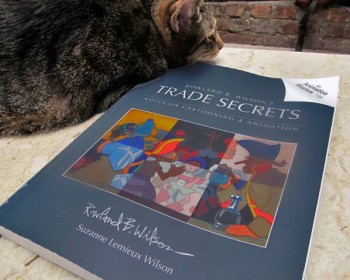 – Finally, I’ve received my copy of the book by Rowland and Suzanne Lemieux Wilson.
– Finally, I’ve received my copy of the book by Rowland and Suzanne Lemieux Wilson.
Rowland B. Wilson’s Trade Secrets / Notes on Cartooning and Animation.
I’d been waiting for this book to come to me since last April when I ordered it. With barely a few hours to scan through it, I can attest to the fact that I think it was well worth the wait. There’s so much there there.
The depth of information on every page is enormous, and just perusing the book, flipping the pages, takes time because the material within is elaborate and complicated. Yet, watching Rowland Wilson break down the information makes you realize what you already know from studying his cartoons: this guy knows a lot, and all of it goes into the choices he’s made in every cartoon.
Consequently, with the book in my hands for only a couple of days, I can’t possibly review it. It’s going to take a long bit of time. I’ll give you a couple of sample pages from the book, so you can see what you’ll be getting if you buy the book (and let me tell you, you should buy this book. It’s a gem, a masterwork of information that’s near-impossible to see collected anywhere. But it takes time.)
The book gives many and varied sheaves of information. At first, I’ve scanned a couple of pages of thoughts on character models. Here are two:
one on women:
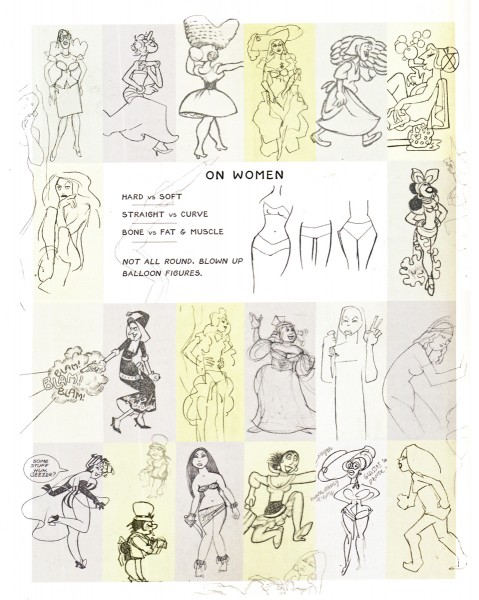 1
1and one on stocky characters:
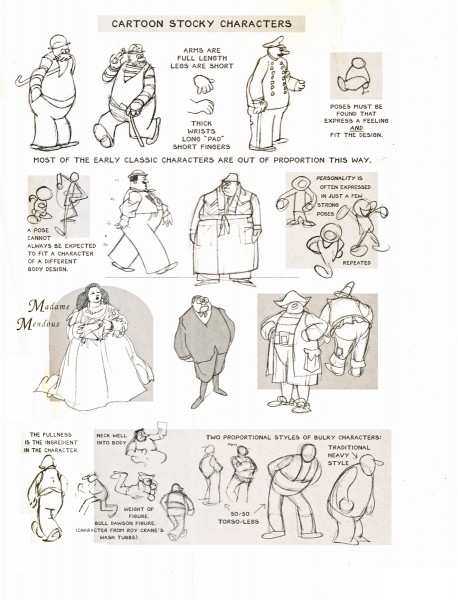 2
2When he gets into the images being created, there’s even a page about iconic imagery within the images being developed. Drawings within drawings.
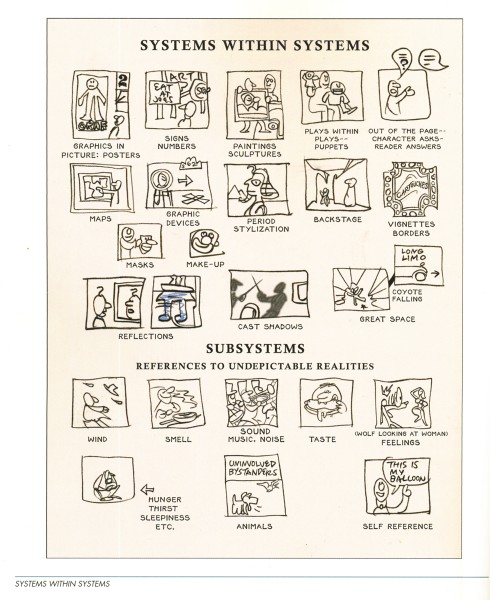 3
3Rowland gets very serious about color and color theories. Here are two adjoining pages which give an overview of color created by varying lighting systems within the drawing.
 4
4
Then there is the section on notes by the great animators, Grim Natwick and Art Babbitt. This section comes from notes Rowland took at the Richard Williams studio when the two came through the London studio. There were lecture courses given for the studio, and this first page includes some caricatures done at the time.
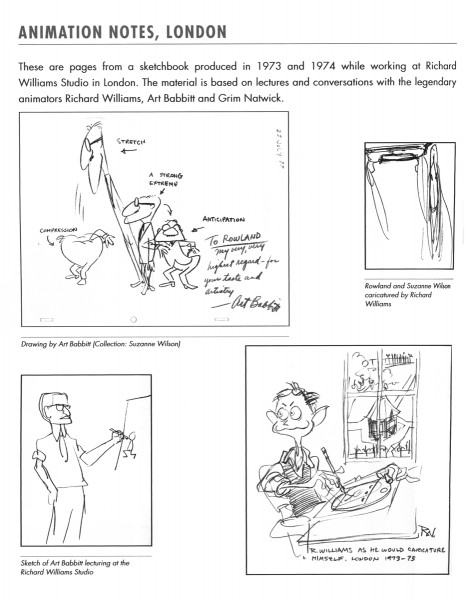 6
6Caricatures done at the Williams’ Studio in Soho Sq.
Here’s a bit of the commentary on Grim Natwick’s lessons:
- GRIM NATWICK AT RICHARD WILLIAMS STUDIO, LONDON
- Grim Natwick was considered one of the world’s greatest animators. He gave a series of talks to animators and was also available for informal conversation during this period (1973-74). We shared the same block of flats and I talked to him often at the studio and after hours. The following is a summation of these talks rearranged according to subject matter.
- GRIM AND THE TRACK— At the time Grim was here I was working on Count Pushkin Vodka (The Trans-Siberian Express animated commercial) and searching for a way to visualize dramatically a musical track. Grim placed great emphasis on the track and the importance of getting to know it thoroughly in order to draw it. At the time he was here I had not started to evolve the the theory of musical form being the basis for animation form. Although Grim never spoke of animation structure as being the same as music structure, on looking back, I see that a number of things he advocated fit into music structure. Art Babbitt’s successive breaking of joints and overlapping action is comparable to the idea of sounding a group of notes in succession, rather than simultaneously. I suspect that the best animators have worked intuitively to principles that are analogous with musical principles. Grim and Art never expressed them that way, exactly.
- DRAWING/ECONOMY— The most controversial theory of Grim’s was to set up a series of related drawings and go into them and out of them and through them in the course of a scene. The animators here felt that the system was not economical due to the amount of mental calculation it took to incorporate a pose in a new way once you had used it. They found the numbering confusing and the doping difficult. Grim presented the idea as an economy and they rejected it on that basis.
- Later in music class it occurred to me the analogy of Grim’s practice with musical practice. The practice of starting with a first and second subject, going through it, repeating it, et cetera,
- I think that Grim’s idea could be called “using a series of HOME KEYS” (animation keys] and is vindicated on aesthetic grounds if not on economic ones.
There’s plenty more where that came from.
Of course, finally, I had to copy this chapter page which includes this great self-caricature by Rowland.
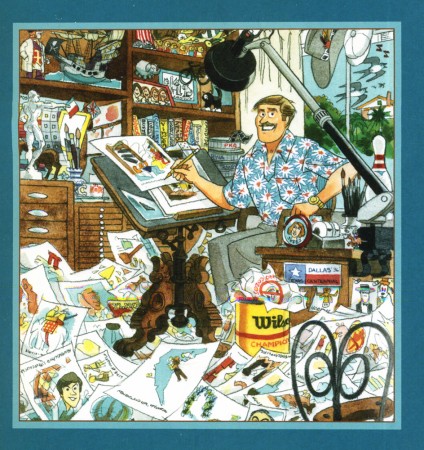
This is a book filled to overflowing with knowledge and information. It makes me realize how little I know and how much there is to learn from masters like Rowland Wilson. He talks briefly about the ad he designed/directed for Riichard Williams, Count Pushkin Vodka. Seeing this ad, alone, is enough to tell you how brilliant Mr. Wilson is and how key it is to learn from such a master. It also says a lot about the man that he spent time preparing these lessons. It also tells me how grateful I am to Suzanne Lemieux Wilson for organizing this material and getting it into shape for publication; I’m sure that was no easy task. I’ll have this book in hand for quite some time to come. In a way, it compares favorably to Richard Williams’ own book on animation, The Animator’s Survival Kit. The difference is that Williams’ book is about acting, performance, and animation; this book is about design, direction and the bigger picture.
Articles on Animation &John Canemaker &repeated posts &Tissa David 22 Jul 2012 04:46 am
Tissa – 1975
- The 1975 issue of Millimeter Magazine is an animation issue. There are a number of enormously informative articles. I was rereading a copy of the magazine, this past weekend, when I came across the Close Up section, wherein a couple of bios appear.
I’d like to show one for Tissa David that was included. I assumed John Canemaker authored the piece; there is no byline. When I asked him, he responded thus: “I wrote the article on Tissa. The quotes are from my first formal interview with her. It was for Millimeter when I was the animation editor and put together special animation issues.”
Tissa looks so young in that photo.
-
“I am a frustrated comedienne, for sure,” Tissa David will tell you, only if you ask. “I am a clown. If I weren’t shy, I’d probably be on the stage.” Instead she is an animator, one of the world’s best and busiest, and one of the few women to have reached the top in the traditionally male-dominated animated cartoon field.
She joyfully toils in her East-Side New York apartment, a warm, plant-filled place that often smells of baked apples. Classical music swirls quietly from a radio and the glow cast from the light under her animation board gives her the look of a sorceress.
 The lady has class—a fact one gathers upon first meeting, but a fact that is reaffirmed by catching a look at the creatures she is conjuring to life on her drawing board. The graphic line is strong and free, yet elegant (as is the artist); and when the drawings are flipped, the creatures move through their paces with a deliciously droll humor, a wit that is uniquely Tissa David’s.
The lady has class—a fact one gathers upon first meeting, but a fact that is reaffirmed by catching a look at the creatures she is conjuring to life on her drawing board. The graphic line is strong and free, yet elegant (as is the artist); and when the drawings are flipped, the creatures move through their paces with a deliciously droll humor, a wit that is uniquely Tissa David’s.
As a child in her native Hungary, Tissa saw Disney’s SNOW WHITE and thought (as so many others have thought after experiencing that film masterpiece), “Now this is something I want to do.” After graduating from art school, she became an assistant animator at Magyar Film Iroda in Budapest; a little more than a year later, in 1945, she was a co-owner of the Studio Mackassy and Trsi supervising all phases of production including story and camera and was sole animator of the puppet and cartoon films.
She left Hungary in 1950 during the height of the Stalin regime, and finally landed in Paris.
Jean Image Productions hired her in September 1951 and for two years she read sound tracks, planned layouts, animated, and did the entire editing of the feature-length, BONJOUR PARIS (1953). That studio closed and Tissa animated at La Comete next, a studio that had been Paul Grimault’s.
“I had absolutely no relatives outside of Hungary except in the United States. So I asked for a visa in 1950. It took at that time five years to get a visa, that was still the quota system. So I came to New York…I loved the U.P.A. cartoons. I decided I wanted to work in that studio.” In 1956, the United Productions of America’s New York Studio was the last tenant in a brownstone on Fifth Avenue and 53rd Street slated to be torn down for the construction of the 666 Tishman Building. There was a French girl in the UPA studio and so she introduced me,” Tissa recalls. “I had no sample reel. I went in once to make a sort of tryout. I was scared; I didn’t speak English, so I was just waiting, waiting, and Grim came by…Grim Natwick is the history of animation and I can rave about him. He created Betty Boop and animated the character of Snow White all the way through. UPA had an awful lot of work and they needed an assistant to Grim.”
At that initial meeting, Natwick boomed, “Now, you know what animation is!” Tissa quietly answered, “Animation is—animation.” Natwick laughed, “You can’t argue with that!” and thus began a professional partnership that lasted twelve years. “Isn’t it strange,” says Tissa today, “that SNOW WHITE got me into animation and I really learned my animation from Grim. I know a great deal about animation, I know I know, because even today I don’t do one line without something in my brain Grim told me.”
After UPA closed in 1958, Tissa and Grim freelanced as a team on countless TV commercials, and since Grim’s retirement, Tissa has soloed successfully and most notably on several John Hubley projects, i.s.: Of Demons and Men (1970), Eggs (1970), Children’s Television Workshop segments Cool Pool Fool, True Blue Sue, Truth Ruth and others, and Cockaboody (1973). Her latest animations include three CTW Letterman episodes, a scene in Shamus Culhane’s Noah’s Ark production, and over 110 feet of Hubley’s Bicentennial film, People, People, People. She has just completed some experimental animation fora Dick Williams project and is now starting, also for Hubley, a TV special based on Erik Erikson’s writings.
A description of Tissa David’s style of animation is difficult; for while it is a distillation of the Disney influence in timing, the UPA sense of humor-through-graphic-design, and the strong, poetic John Hubley mode, it also contains a different character, unique to Tissa David, that she calls the “female difference…If the same scene is animated by a man and by me, there will be a great difference, not in quality but in interpretation. John Hubley told me I have a fine sense for detail, not in the drawing itself because I make very loose drawings, but in a scene, in expressing feelings. I am a very intuitive animator—I never know when I sit down to work what will happen.”
 For all her gentleness, Tissa also contains an inner core of strength exhibited in her single-minded devotion to her art. Her opinions about that art, herself and other topics, is disarmingly to-the-point: “I believe very strongly that one must know how to draw,” she will offer on the subject of how-to-animate. “Even if you just animate objects, you must have a knowledge of drawing.” As for her struggles securing her place in animation, Tissa will admit, “…its very hard. Women can find work in animation if they have enough will to follow through and really do it. Even today, I’m always saying if I keep busy long enough, I will become a good animator.”
For all her gentleness, Tissa also contains an inner core of strength exhibited in her single-minded devotion to her art. Her opinions about that art, herself and other topics, is disarmingly to-the-point: “I believe very strongly that one must know how to draw,” she will offer on the subject of how-to-animate. “Even if you just animate objects, you must have a knowledge of drawing.” As for her struggles securing her place in animation, Tissa will admit, “…its very hard. Women can find work in animation if they have enough will to follow through and really do it. Even today, I’m always saying if I keep busy long enough, I will become a good animator.”
At the time this piece was written, Tissa was completing work on a pilot for Dick Williams’ film, Raggedy Ann & Andy; this one minute piece got Dick the film over Joe Oriolo and Shamus Culhane. She would thereafter work on John Hubley’s Doonsebury Special (just as he died mid film); and she was to animate for R.O.Blechman’s Simple Gifts.
Here’s a more recent photo of Tissa.

Tissa David was 91 last January.
Animation &Animation Artifacts &Frame Grabs &UPA 22 May 2012 06:55 am
Nelly Bly’s Twisted Arms
This is one of my favorite scenes of all time. Nelly Bly is on the witness stand, and she’s constantly straightening herself out as she gets deeper and deeper into her side of the story. Grim Natwick’s animation is perfect, and John Hubley’s direction and design is even better. The judge, behind her, couldn’t be better positioned.
This is a great cartoon, possibly UPA’s best. It lost the Oscar to The Two Mousketeers, a Tom and Jerry cartoon, and not even a particularly good Tom and Jerry cartoon. It would take another ten years before AMPAS ruled that you had to see the short films to be able to vote on them.
I tried to include this scene with its soundtrack, but it took longer than I could afford to give it.
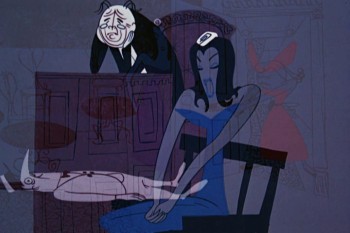 01
01
______________________
The bump in the middle is a hold wherein there’s a
camera move. I replaced it with a short dissolve.
Frame Grabs &UPA 07 May 2012 05:36 am
Julian’s Georgie
- Well, I’m following my fancy. I’m into Paul Julian‘s beautiful painting style, and have found a treasure trove in the UPA collection DVD, Jolly Frolics. Here I have one of the better UPA films, Georgie and the Dragon. It’s a rather simple story, beautifully directed by Bobe Cannon and animated by Rudy Larriva, Bill Melendez, Grim Natwick and Frank Smith. The exceptional script is written by three strong, animation pillars: John Hubley, Bill Scott and Phil Eastman. Paul Julian and Jules Engel seem to have done the backgrounds together.
 1
1The tartan BG with the yellow type sets up
the Scottish location for the film.
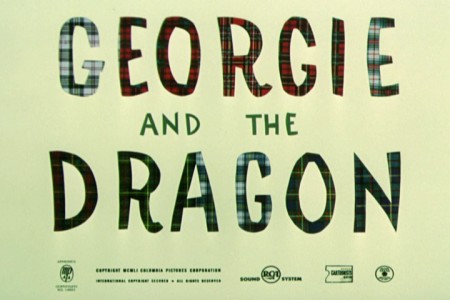 2
2
For the second card they reverse the scheme:
yellow BG with a tartan filled type.

The credits dissolve as the BG pans
and the camera slowly moves in.
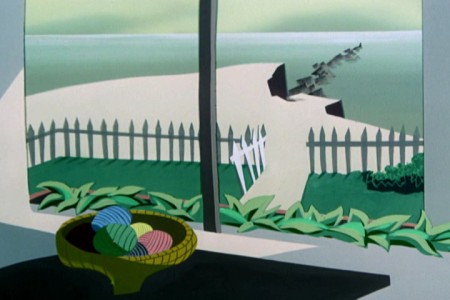 6
6
I think you can distinguish between the Paul Julian Bgs
and the Jules Engel bgs. Julian was more apt to use
drybrush in his work, and it gives it a singular look.
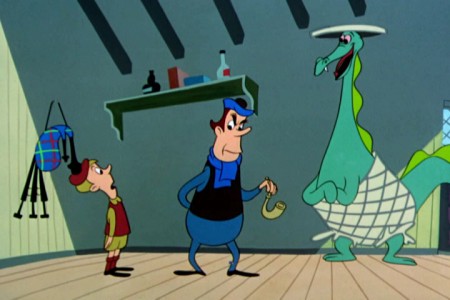 27
27
Just look at these wild poses even though
the characters are at rest.
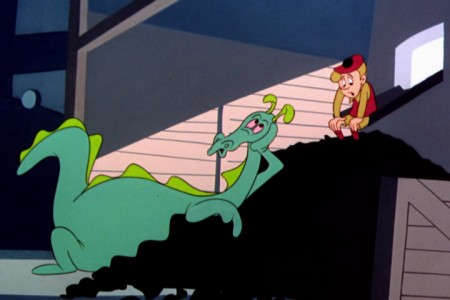 41
41
UPA didn’t just introduce a new kind of design,
it brought a new style of animation that made
that design work.
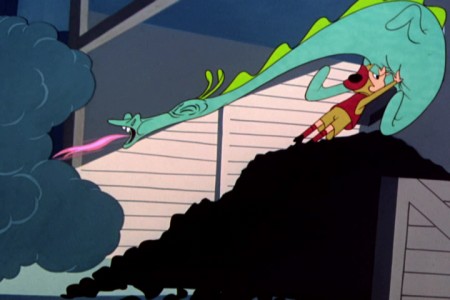 42
42
Bobe Cannon was the perfect animator to direct
the animators in this new looseness and sense of
graphic movement in animation.
Go here to see the comic book adaptation of the cartoon.
I found the following model sheets on Stephen Worth‘s excellent site, AnimationResources.
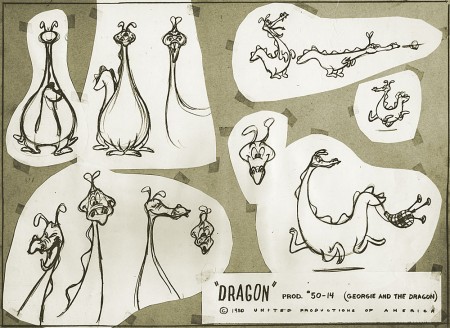
Animation Artifacts &Fleischer &Models 02 May 2012 05:43 am
Vince Cafarelli’s Gulliver Models
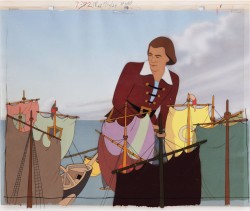 - The last few times I’d met with Vince Cafarelli, before he died, he’d told me that he had some things he wanted to have me put on my blog. Candy Kugel has, recently, shown me the material he’d been offering. There’s a treasure of artifacts there, and it’s going to take a lot of time to display them all.
- The last few times I’d met with Vince Cafarelli, before he died, he’d told me that he had some things he wanted to have me put on my blog. Candy Kugel has, recently, shown me the material he’d been offering. There’s a treasure of artifacts there, and it’s going to take a lot of time to display them all.
It turns out that when Vince started as a runner at Famous Studios in 1948, at one point, he found that the studio was dumping a lot of old material, and rather than let it be discarded, he took what he wanted. Fabulous gems. There’s an almost complete storyboard for a 1949 Popeye cartoon by Jack Mercer and Carl Meyer, and there are a lot of model sheets. There’s plenty of beautiful and rare work to post in the coming weeks.
I’ve decided to devote Wednesdays to the Vince Cafarelli Collection, and will start this week with all the models that came from Gulliver’s Travels.
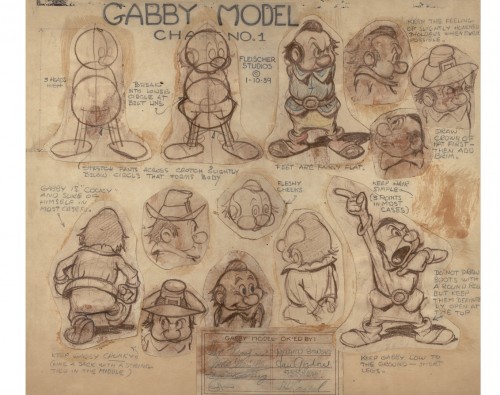 1
1Several of the models, including this one, are the actual thing.
Pencil drawn originals including even the signatures approving the model.
Models approved by: Seymour Kneitel, Eddie “Hurray” Seward,
Max Fleischer, Dave Fleischer, Dan Gordon, Willard Bowsky and
Frank Kelling.
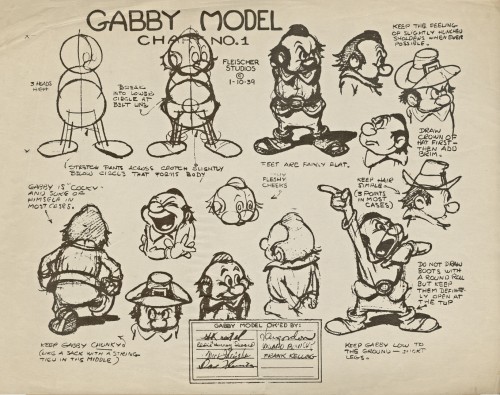 2
2
Most of them, including this one, are lithos done for the animators.
Model sheet approved by: Dave Fleischer, Max Fleischer, Frank Kelling,
Grim Natwick, Willard Bowsky, Dan Gordon, (Eddie) Seward, and
Seymour Kneitel
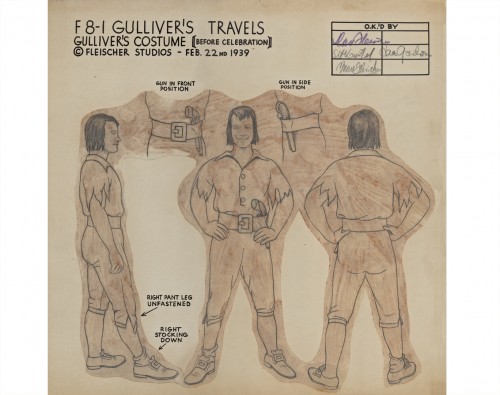 3
3
An original pencil drawn model.
Approved by: Dave, Fleischer, Seymour Kneitel,
Max Fleischer, and Dan Gordon
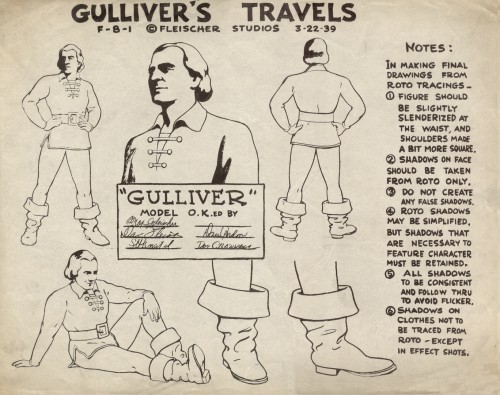 4
4
Approved by: Max Fleischer, Dave Fleischer,
Seymour Kneitel, Dan Gordon, and Doc Crandall
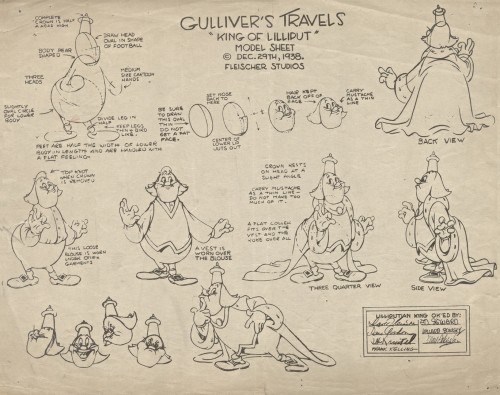 5
5
Approved by: Dave Fleischer, Dan Girdon, Seymour Kneitel,
Frank Kelling, Eddie Seward, Willard Bowsky and Max Fleischer
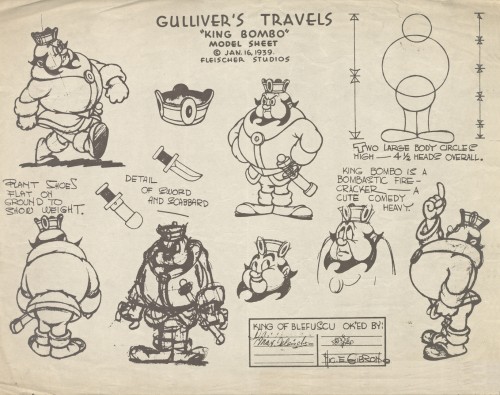 6
6
Approved by: Dave Fleischer, Max Fleischer,
Eddie Seward, and Hig. E. Gibson
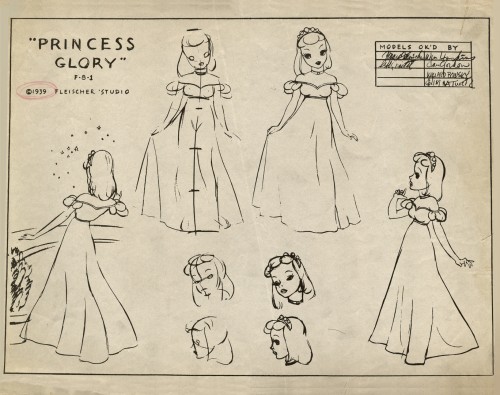 7
7
Approved by: Max Fleischer, William Hoskins, Dan Gordon,
Willard Bowsky and Grim Natwick
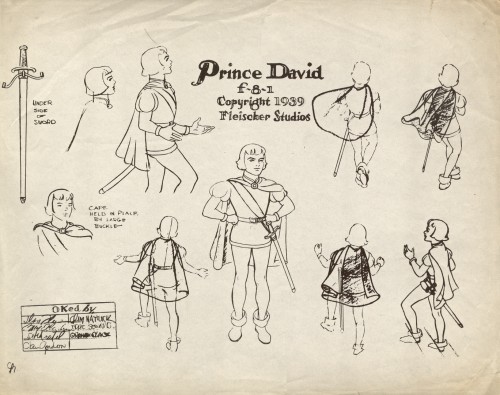 8
8
Approved by: Max Fleischer, Seymour Kneitel, Dan Gordon,
Grim Natwick, Eddie Seward, and Graham Place.
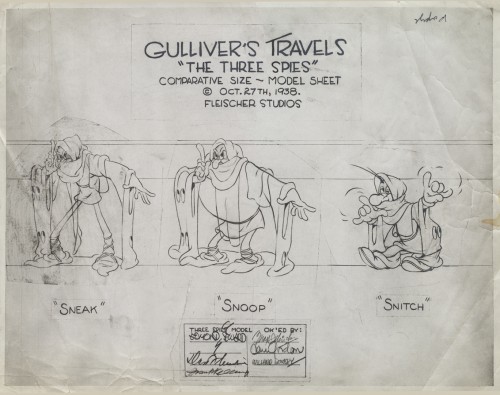 9
9
Approved by: Edmond Seward, Dave Fleischer, Frank Kelling,
Max Fleischer, Dan Gordon and Willard Bowsky
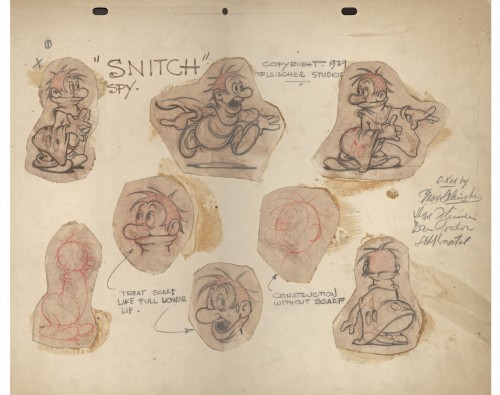 10
10
An original pencil drawn model.
Approved by: Max Fleischer, Dave Fleischer,
Dan Gordon and Seymour Kneitel
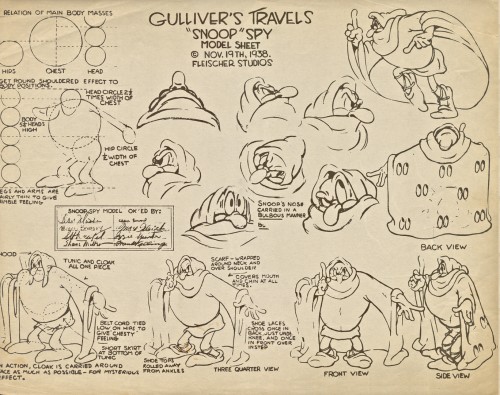 11
11
Approved by: Dave Fleischer, Willard Bowsky, Seymour Kneitel,
Shane Miller, Eddie Seward, Max Fleischer, Izzie Sparber, and
Frank Kelling
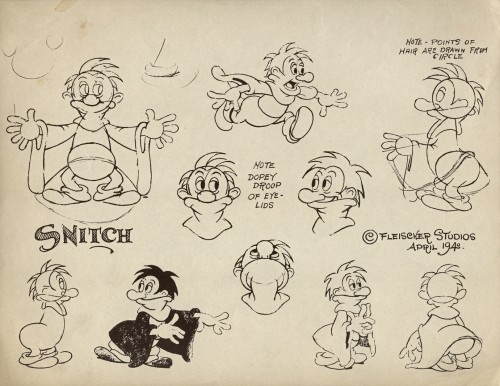 12
12
This model is a smaller size in the collection.
No approval names listed.
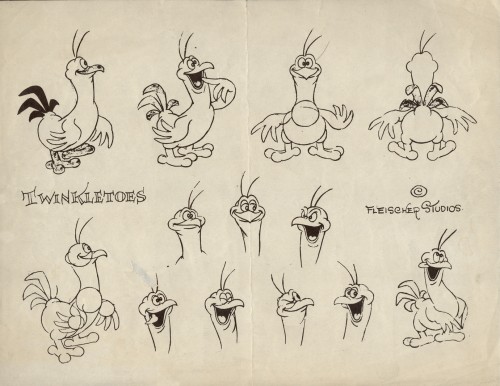 13
13
This is also a smaller sized model sheet.
No approval names listed.
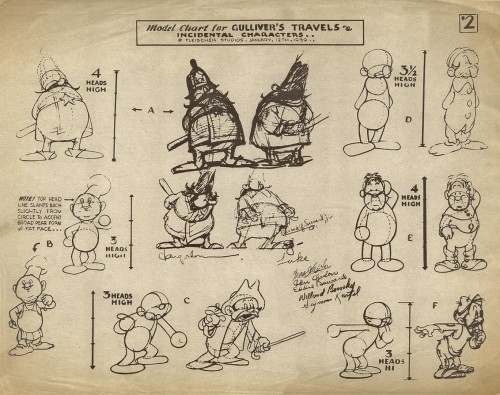 14
14
Approved by: Max Fleischer, Dan Gordon,
Eddie Seward, Willard Bowsky, and Seymour Kneitel
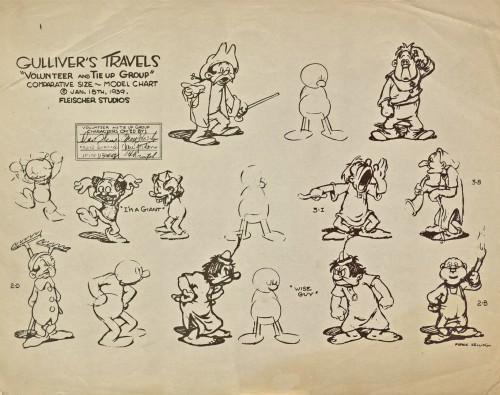 15
15
Approved by: Dave Fleischer, Eddie Seward, Willard Bowsky,
Max Fleischer, Dan Gordon and Seymour Kneitel
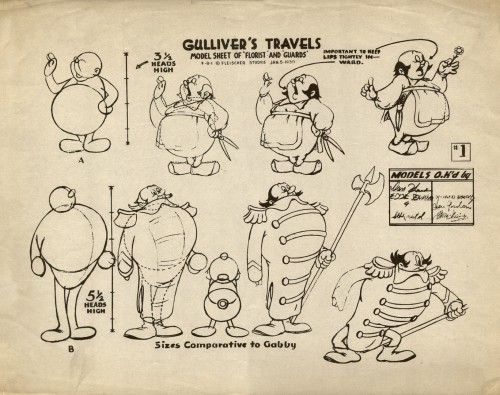 16
16
Approved by: Dan Gordon, Eddie Seward, “G”,
Seymour Kneitel, Willard Bowsky, Dan Gordon,
and Max Fleischer
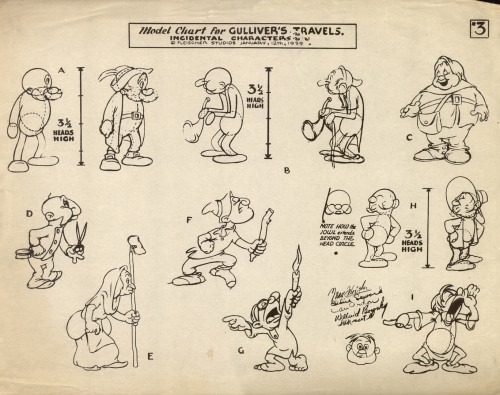 17
17
Approved by: Max Fleischer, Eddie Seward, Dan Gordon,
Willard Bowsky and Seymour Kneitel
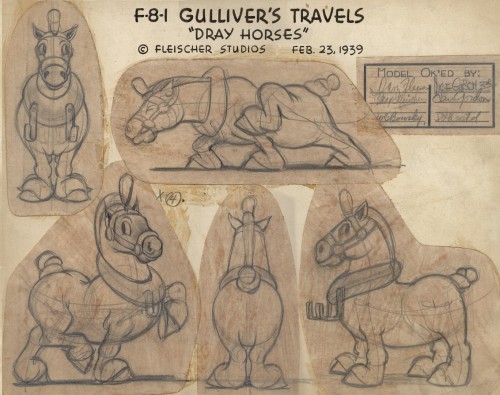 18
18
An original pencil drawn model.
Approved by” Dave Fleischer, Max Fleischer, Nic. E. Gibson,
Dan Gordon and Seymour Kneitel
Animation &Animation Artifacts &repeated posts &Tissa David 11 Jan 2012 06:03 am
Hillbilly Run Cycles – Grim Natwick/Tissa David
- When I first started in animation at the Hubley Studio, I met Tissa David. She recognized how poor my inbetweens were and took me under her wing to try to correct the situation. She gave me private lessons for years. Often she would give me scenes animated by her mentor, Grim Natwick, and she would ask me to remove every other drawing and do new inbetweens for what was left. When I finally got them close to being correct, she’d have me do clean-ups of Grim’s work.
These two run cycles were among the first drawings she gave me to rework. Back then, the only way to see the drawings in motion was to flip them or film them. There were no computers to see them instantaneously moving. You can just go to the bottom of each cycle, and I’ve added a QT pencil test,
I might suggest that if you’re just starting out, you should print out the drawings and then do new versions of the inbetweens for the even numbered drawings. Go back to Tissa’s versions to compare with what you did.
Grim Natwick animated this spot for Mountain Dew when he worked for Robert Lawrence Productions. Here are two run cycles from that spot. It was assisted by Tissa David. All of the drawings, here, are Tissa’s clean-ups.
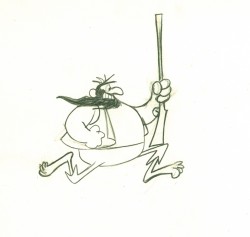 1
1 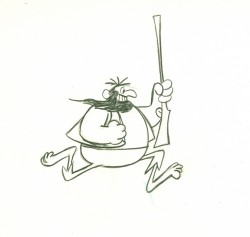 2
2
(Click any image to enlarge to full size.)
On ones at 24FPS
Click left side of bar to play.
Right side to watch single frame.
This is another run cycle from that same film. Again, all of the drawings, here, are Tissa’s clean-ups.
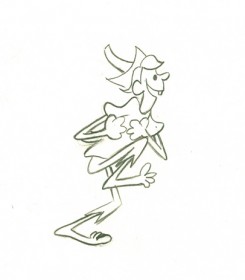 1
1 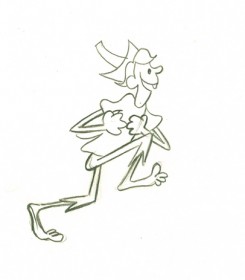 2
2
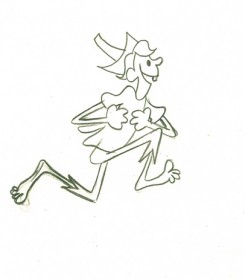 3
3 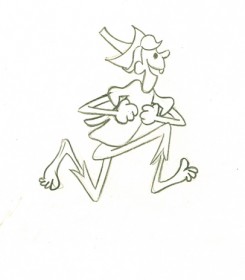 4
4
You’ll note that the character leaves the ground for 1/3 of the spot.
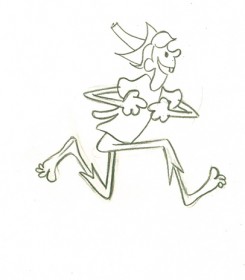 5
5 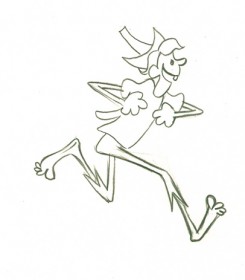 6
6
I love the chicken movement this guy is doing with his arms.
A laugh riot of a run cycle.
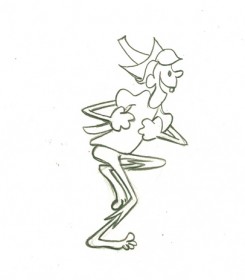 9
9 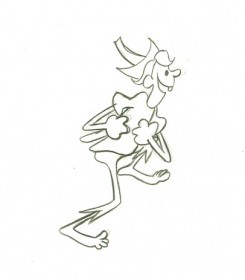 10
10
He actually comes down in the crossing position rather than the
classically designed walk where the head moves up.
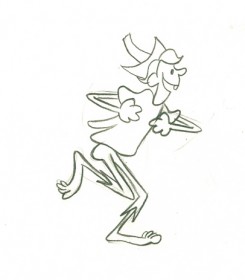 17
17 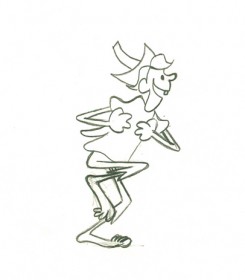 18
18
Tissa’s tendency is to have the crossing position the lowest in the cycle.
The character bears the weight of his walk with feet solidly on ground.
On ones at 24FPS
Click left side of black bar to play.
Right side to watch single frame.
This was originally posted in May 2009.
Commentary &Frame Grabs 12 Dec 2011 06:03 am
Iwerks’ Sinbad
– When I was young, about 12 years old, I saved my money to buy an 8mm projector. This was long before DVDs, before VHS tapes and before even Super 8mm. The used projector cost me $20. I bought it from a NY store called Peerless Photo Equipment. They also had a large department of home market 8mm shorts that could be bought for relatively little money. Lots of Castle films (meaning Universal short subjects 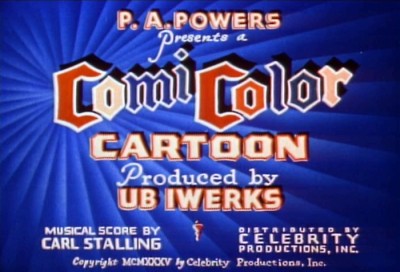 Walter Lantz Woody Woodpecker), a few Disney shorts, a few WB shorts and plenty of Ub Iwerks films. I was an Iwerks fan and my immediate interest was in these films which I had never seen. The same day I bought that projector, I bought a 6 min version of “Jack & the Beanstalk” as well as a 3 min version of “Sinbad the Sailor.” Both were sold only in B&W, and they were silent with a few intertitles. (It’s amazing how well they worked as silents.)
Walter Lantz Woody Woodpecker), a few Disney shorts, a few WB shorts and plenty of Ub Iwerks films. I was an Iwerks fan and my immediate interest was in these films which I had never seen. The same day I bought that projector, I bought a 6 min version of “Jack & the Beanstalk” as well as a 3 min version of “Sinbad the Sailor.” Both were sold only in B&W, and they were silent with a few intertitles. (It’s amazing how well they worked as silents.)
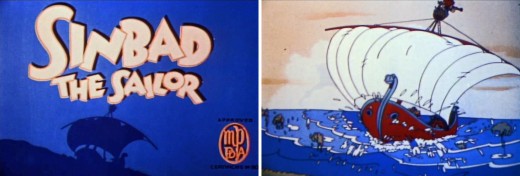
When I finally got to see both films in color it was an amazing surprise for me.
I knew they were in Cinecolor, and I expected much worse than what I got.
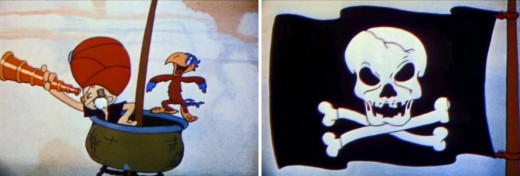
With Sinbad, I was surprised at how little I remembered of that film.
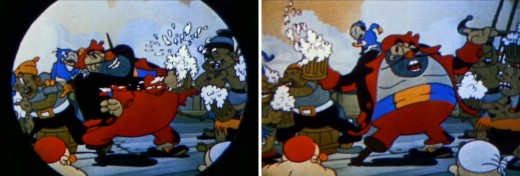
I remembered almost nothing about the pirates. I didn’t forget
Sinbad in the crow’s nest with his parrot espying on the other ship.
I particularly remembered the big bird at the end of the film.
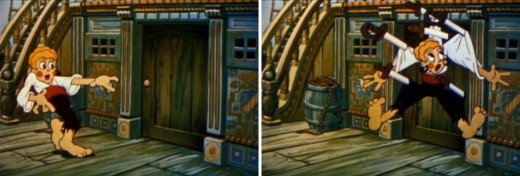
The shortened version did not include this anti-gay joke in it.
Watching it for the first time, I wondered how many other such
jokes were in the films. There were plenty of racist jokes
(including the one I eliminated at the very end of this film.)
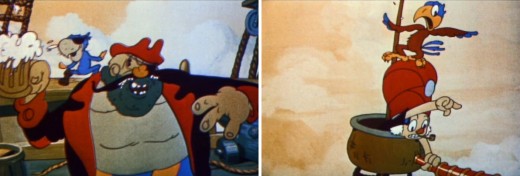
It’s amazing how much those early short films stayed with me over the years,
however this one has just left an impression without my remembering much of
the details of the story.
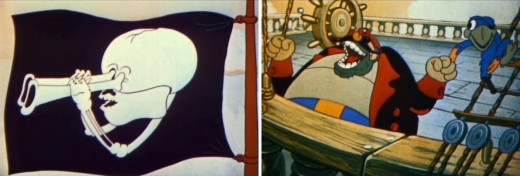
After all, I studied every frame of these films. I’d figured out how to
jerry-rig my 8mm projector to allow me to do that. I could watch each
film one frame at a time.
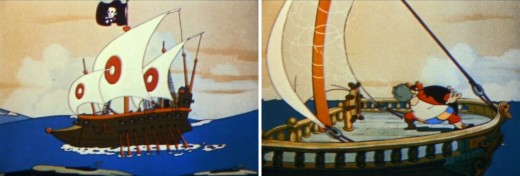
I remember when I first met Grim Natwick that I told him his was the
first animation I ever studied. “Jack & The Beanstalk” left an impression.
Grim wasn’t impressed when I told him.
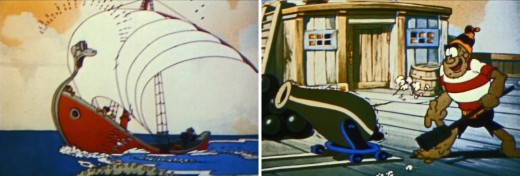
The most I could learn about the crew of this film is that Grim Natwick
(who probably directed) animated along with Stephen Bosustow.
I believe Pete Burness was also with the studio at this time. Berny Wolf
was there at this time and may have animated on Sinbad.
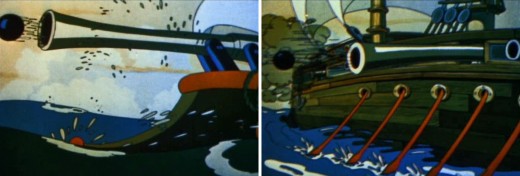
I soon had bought a complete library of animated shorts.
Both “Jack & The Beanstalk” and Woody Woodpecker in
“Ace In The Hole” were favorites of mine back then.
Grim Natwick and Alex Lovy.

I also bought a couple of WB shorts. I particularly liked the
Chuck Jones directed films. I’d seen “Hair Raising Hare” and
“Rabbit Punch” so many times in the 8mm versions that
it’s almost hard to watch them again.
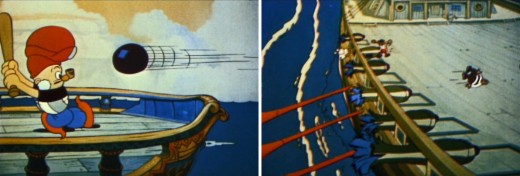
The WB cartoons handled the titles well. They did them
as subtitles, and I liked buying these films for this reason.
Of course, it was a plus that they were such good films.
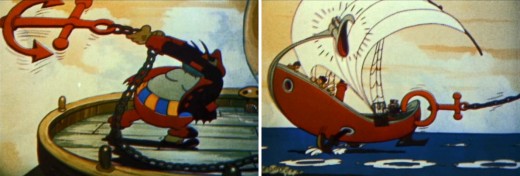
I’m surprised that the Iwerks staff took no attempt to adapt the actual story
of Sinbad from the Arabian Nights, but instead they completely created their own.
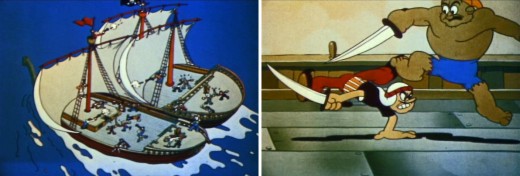
Ted Sears and Otto Englander, were both doing story work for Iwerks,
so they probably had a hand in shaping this film. Eventually, both men
would move on to Disney’s studio where they did exceptional work.
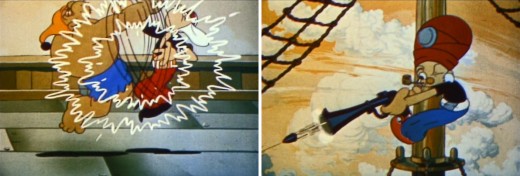
By the time this film was made, Iwerks, himself, had lost interest
in the actual production of the shorts, and he’d tried to get Grim Natwick
to take a piece of the studio to run the production.
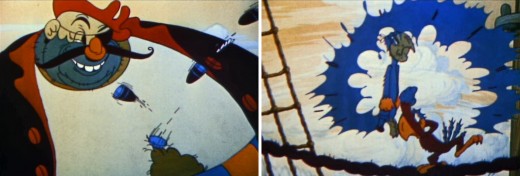
Natwick had refused knowing full well how difficult it was to
manage a studio and try to stay afloat. Especially knowing,
as I’m sure he did, that the studio was in trouble.
He rejected the offer.
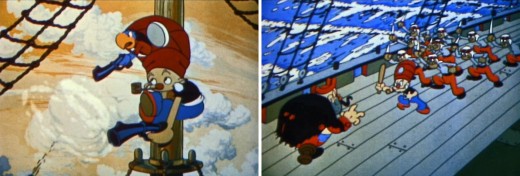
In fact, within a year Natwick, Shamus Culhane and others had
migrated to the Disney studio. Culhane had a side-step going back
to NY to work under Bert Gillette for Van Buren. When that ended
badly, Culhane went to Disney to work for less than he made in NY.
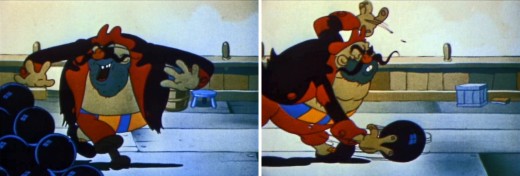
Berny Wolf, Al Eugster and Steve Bosustow also moved to Disney’s.
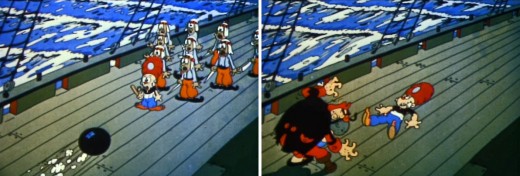
The bowling pin joke has got to be one of the older jokes used in animated films.
I’m sure the addition of sound helped sell the gag during the early sound years.
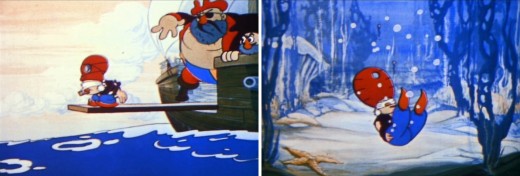
Others at the studio such as Chuck Jones and Frank Tashlin
as well as Bugs Hardaway and composer, Carl Stalling,
moved over to Schlesinger’s studio at Warner Brothers.
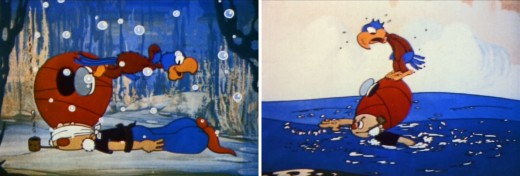
“Sinbad” was part of a trilogy of films Iwerks made from the
Arabian Nights. There was also “Aladdin” and “Ali Baba.”
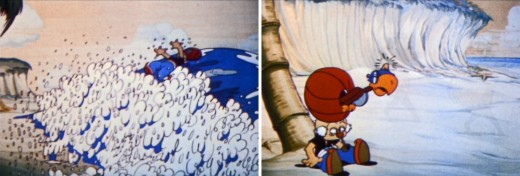
All three were really just titles to hang a cartoon on.
These were part of the attempt to try to gain a bit of success
after Willie Whopper and Flip the Frog had both failed as series.
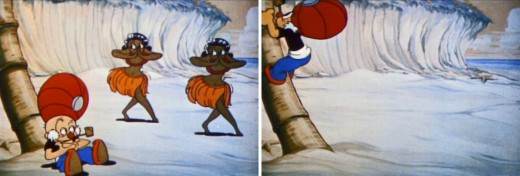
There’s no doubt that Grim Natwick did these dancing girls.
It was his signature style at the time.
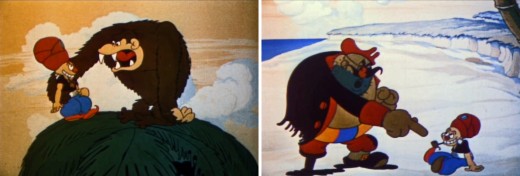
Iwerks was moving his studio to the edge of the precipice.
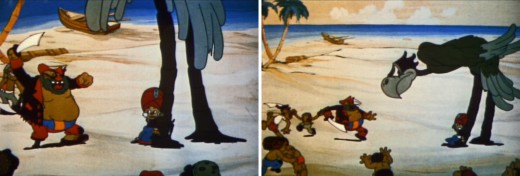
Iwerks introduced his version of the multiplane camera about
this time, trying to offer something new to the medium.
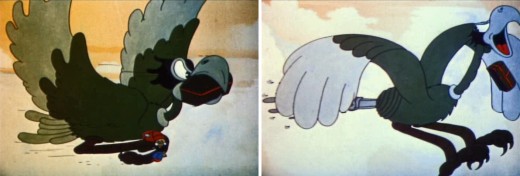
The Headless Horseman and The Valiant Tailor both showcased
the multiplane camera in its production. Neither took off.
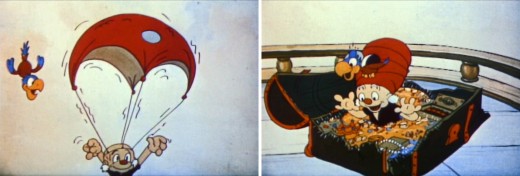
It wasn’t much longer before the Iwerks studio
floundered and ultimately died off.
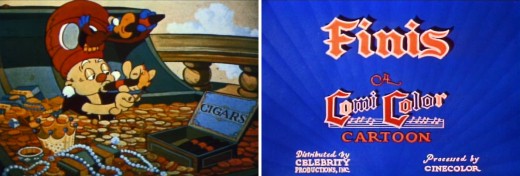
The final joke (cut out) shows the cigar exploding leaving
Sinbad with a black face with just a touch of racist humor.
________________________
.
Here’s the YouTube version of this short.
